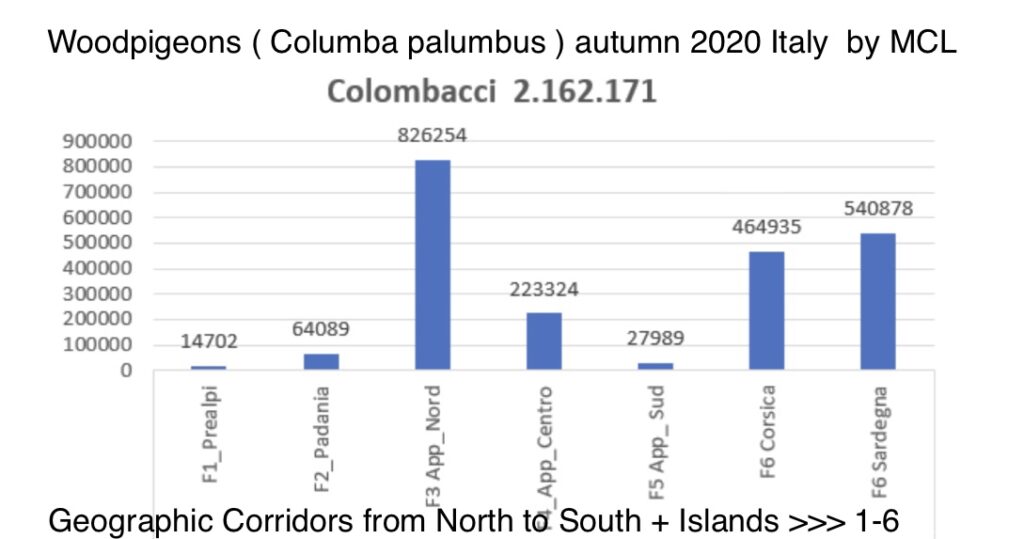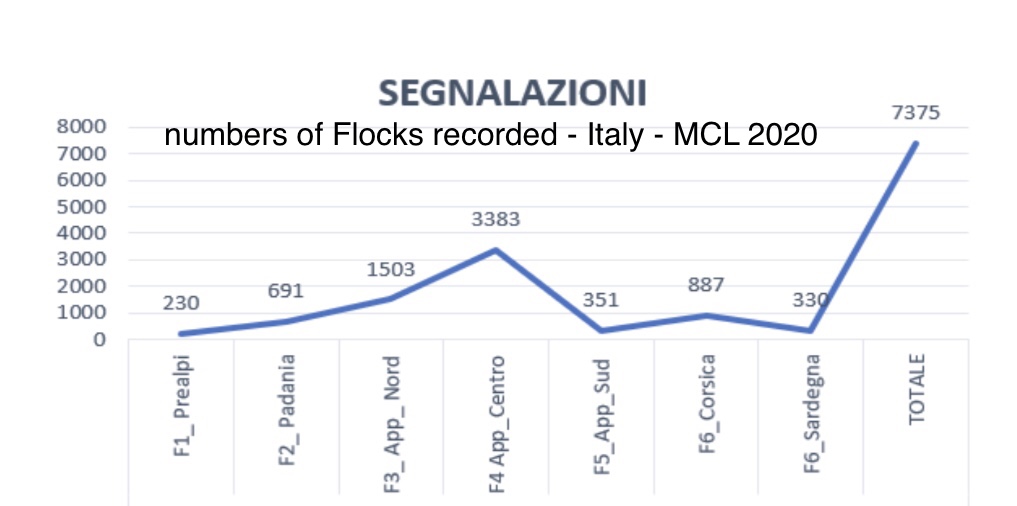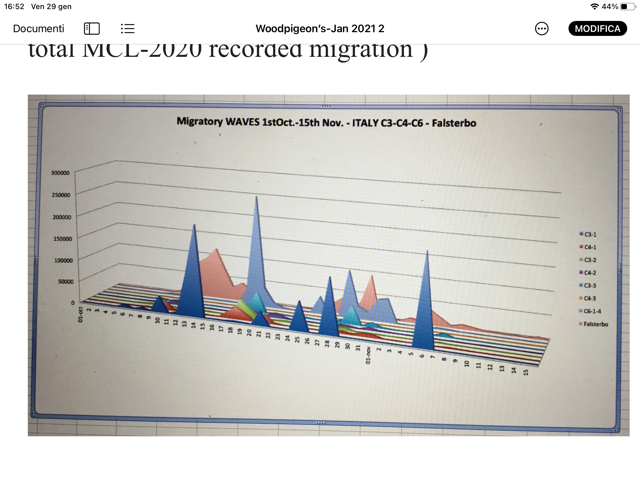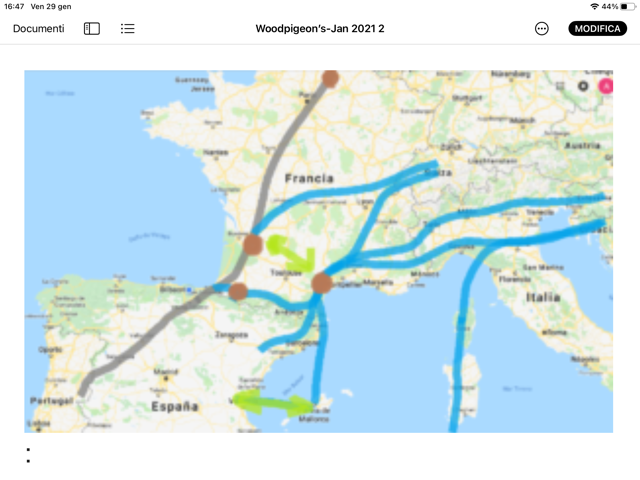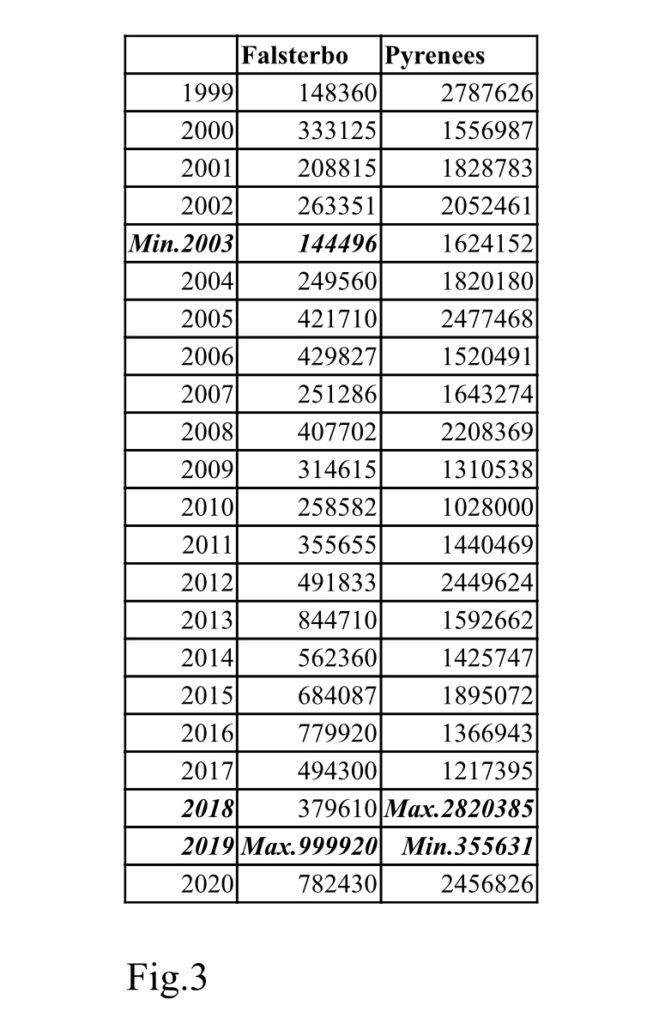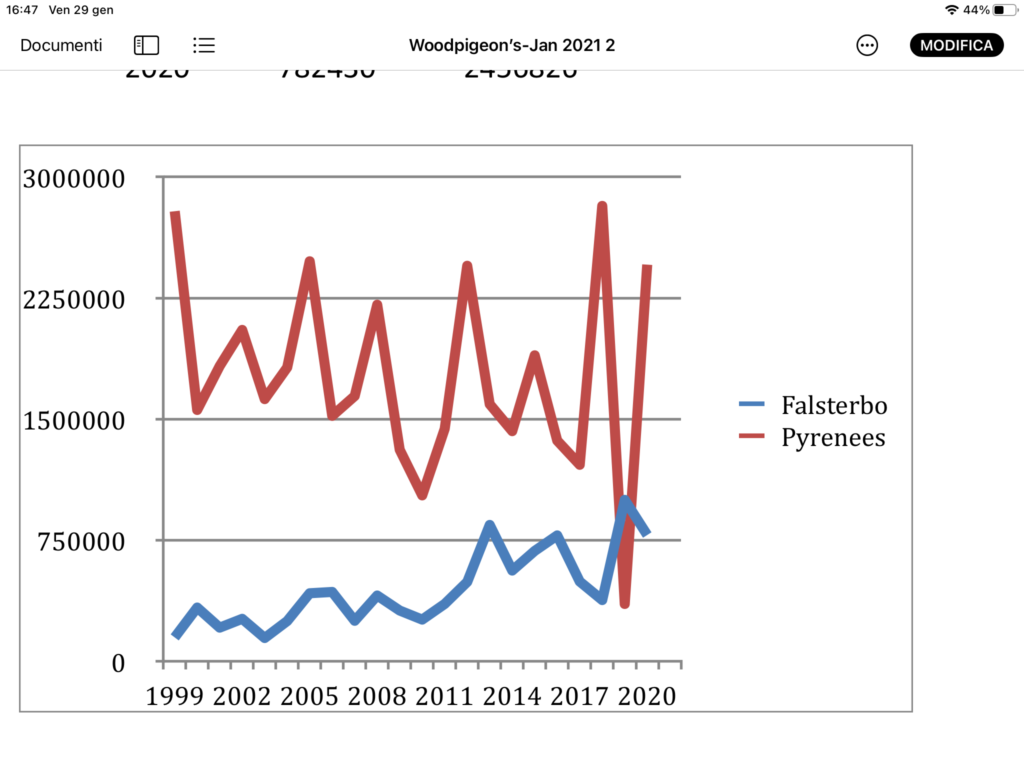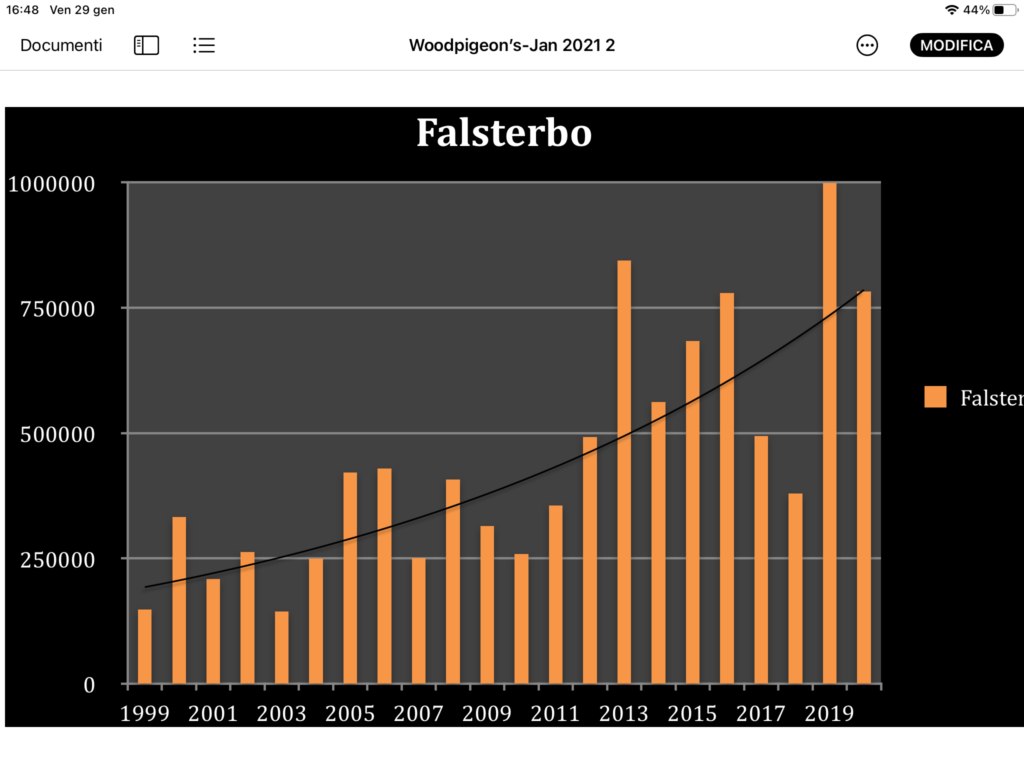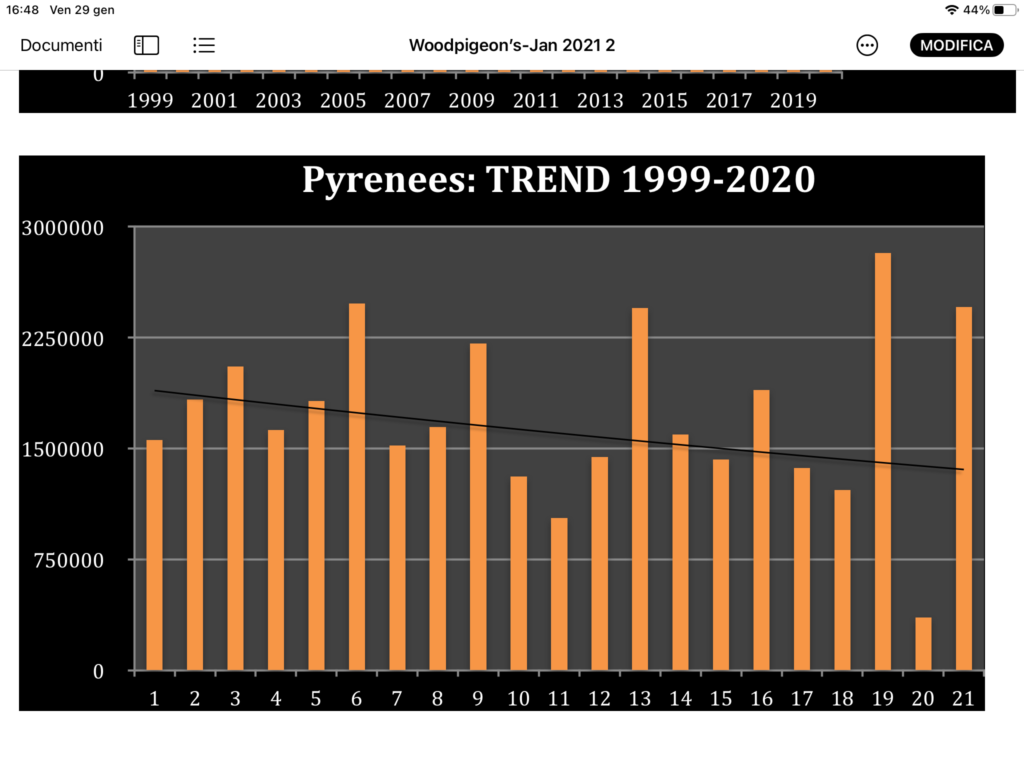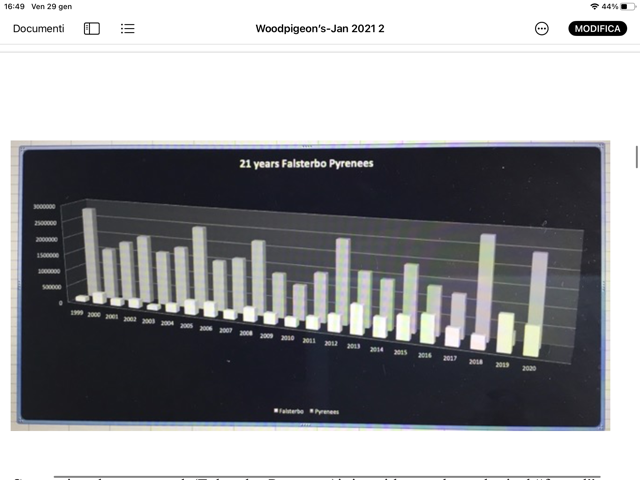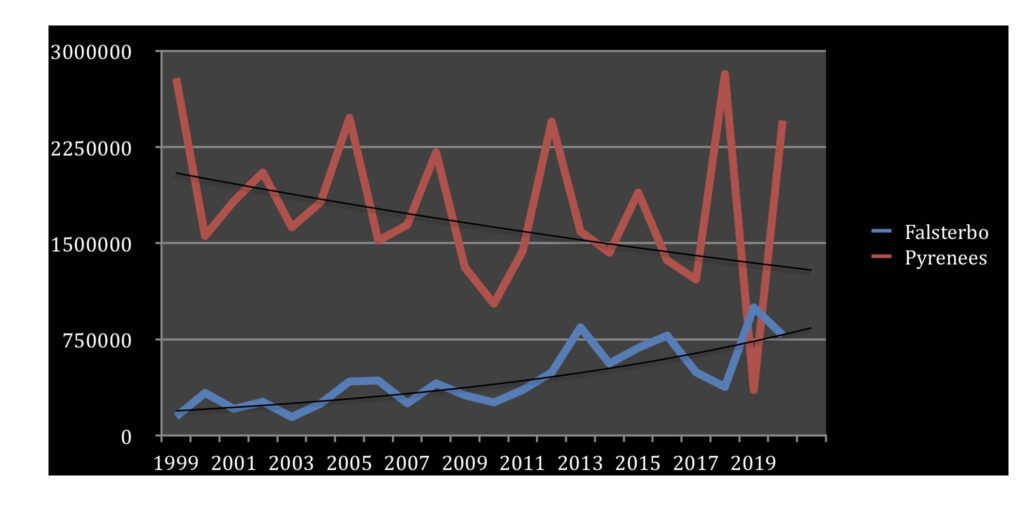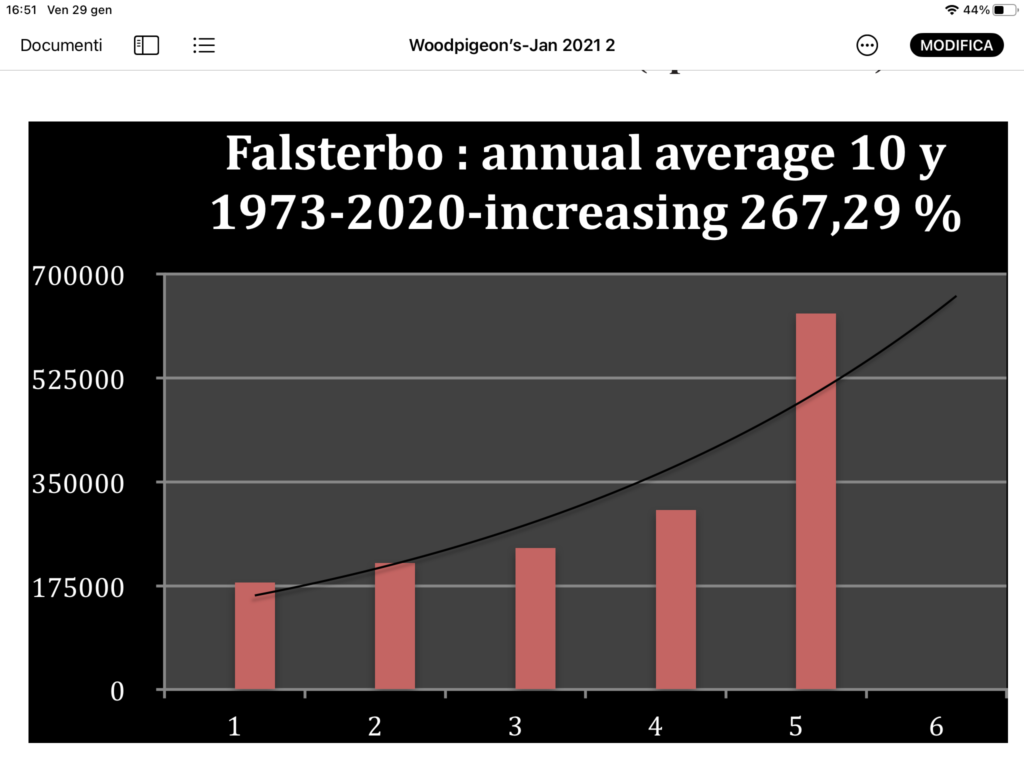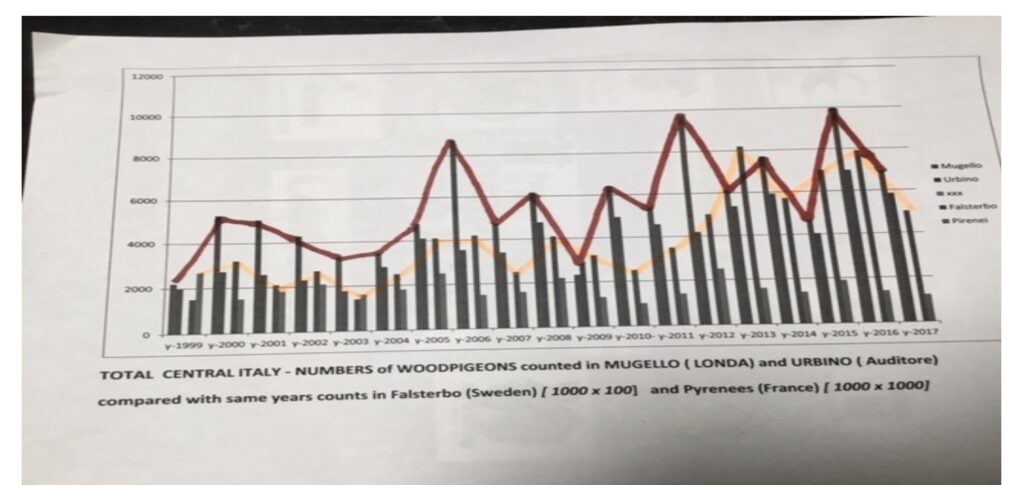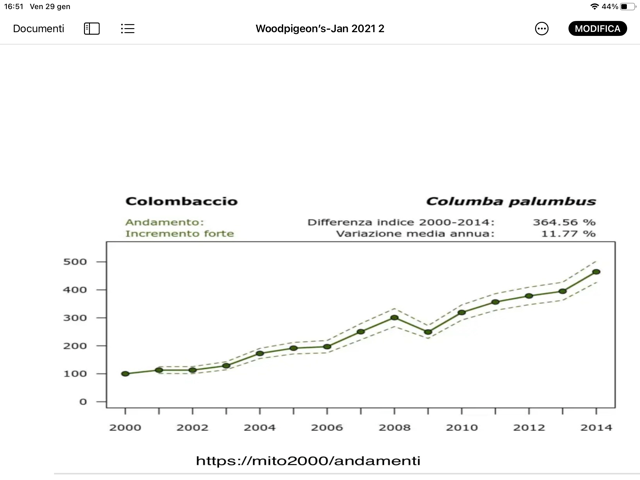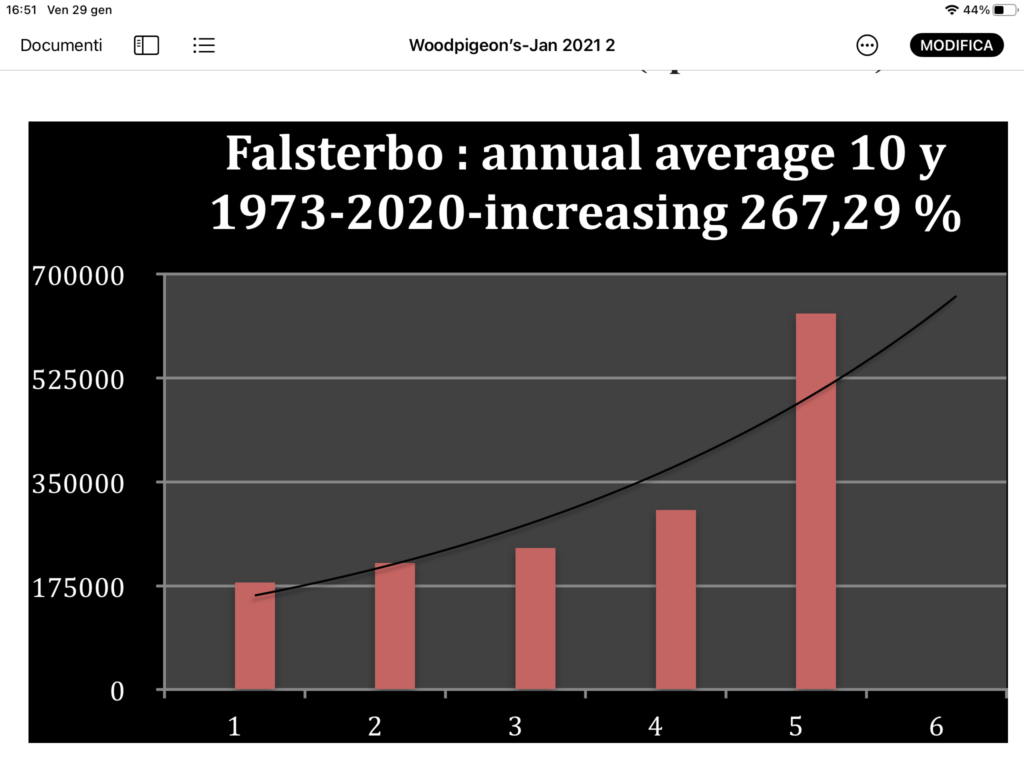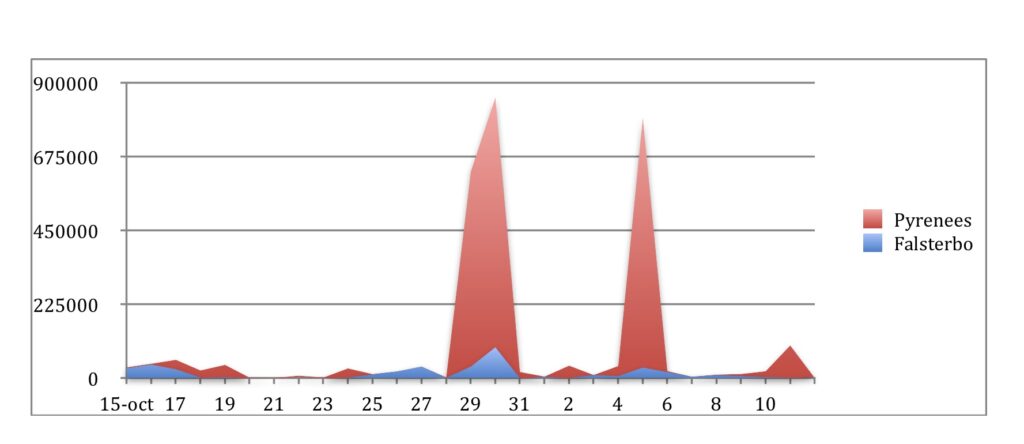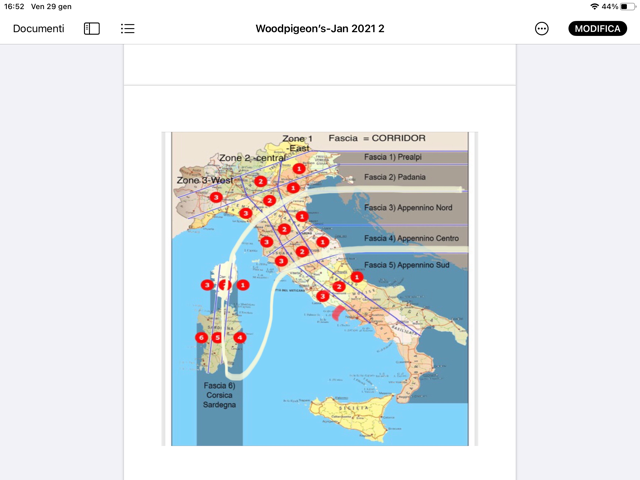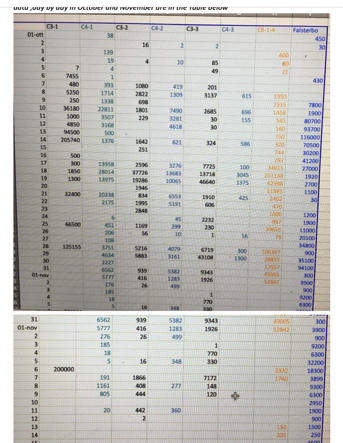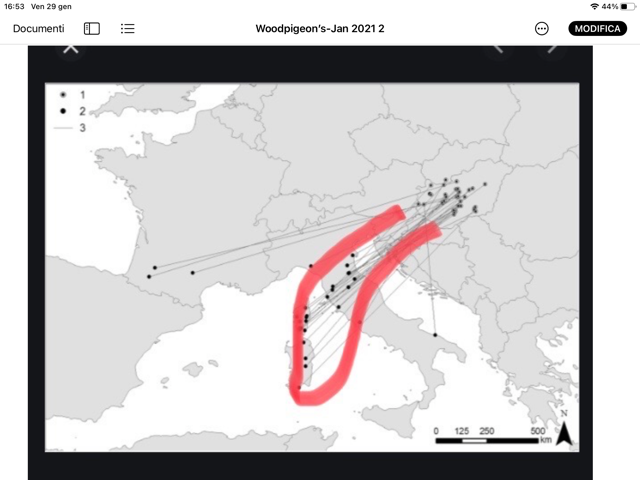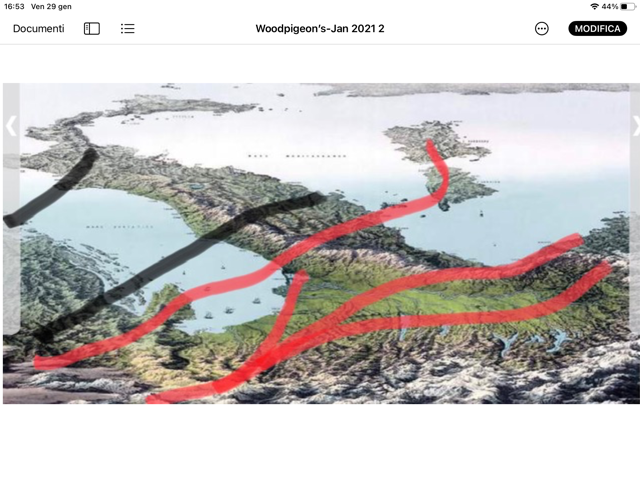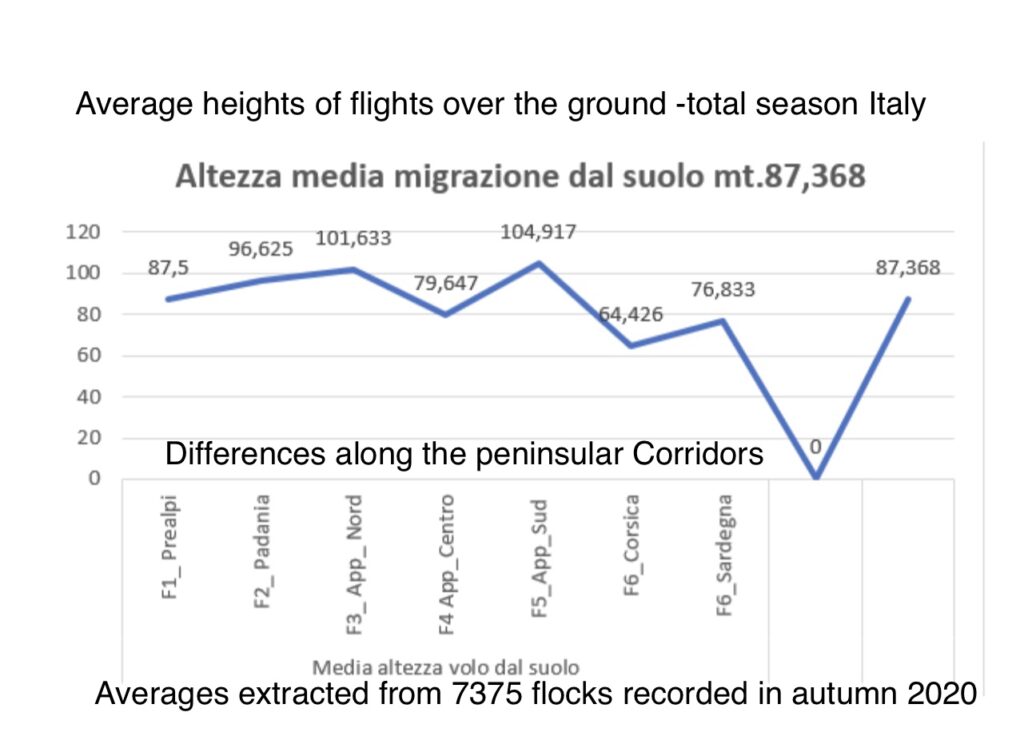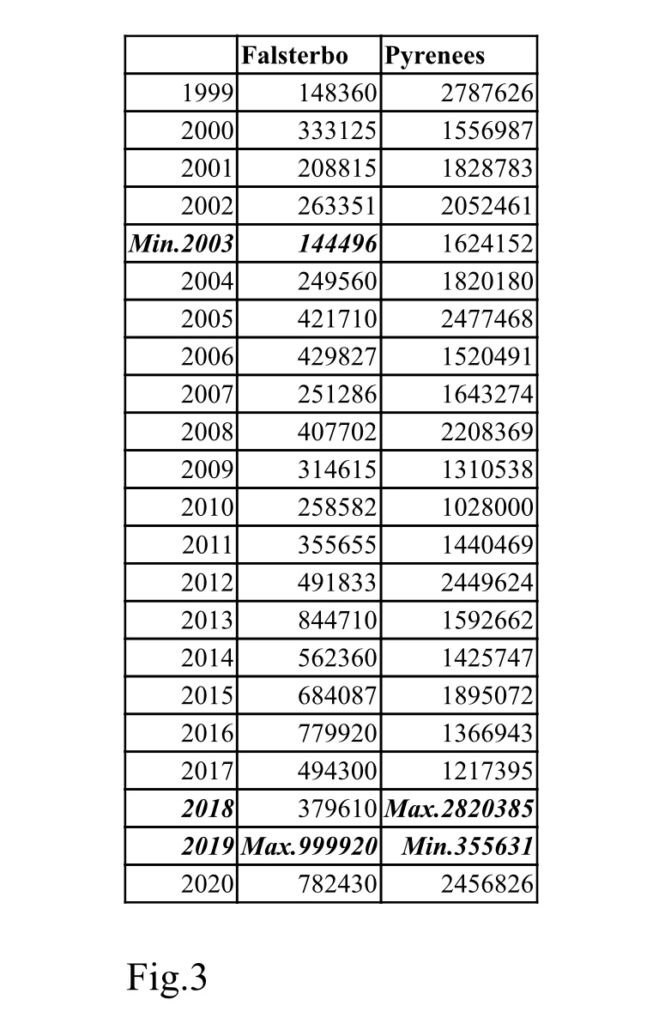Woodpigeon’s ( Columba palumbus ) autumn migration in Europe and Italy : critical updating 2020 by live monitoring (MCL) .
Enrico Cavina , Vasco Feligetti(*)
(*) Club Italiano del Colombaccio
Key-words: woodpigeon migration ,flyways ,flocks,peakes-waves,climatologic changes,abiotic biotic factors,Europe,monitoring methods
ABSTRACT-SUMMARY
More than two millions of Woodpigeons were “live monitored” (MCL supported by observations-records of 154 hunters distributed along 6 selective corridors ) crossing Italy during autumn 2020.
The data collected and available by main Ornithological stations in Europe were updated 2020-
At the beginning 2021 we can adfirm that the “ Research and state of art” concerning Columba palumbus are poor and also the efforts by Citizen Science operators result uncoordinated.
This paper –preliminary of other specific retroactive researches – attempts to highlight the importance of relating the migration data in Europe obtained on the main Flyways (Baltic-North Europe-Central Europe-Meditarranean), also on the basis of a precise 2020 update. At the same time, the global increase in populations of the Western Palearctic is documented, which oscillates between values between 200-300%. We hope for a better commitment of Institutional Ornithology that can also use and manage the data offered by Citizen Science.
Lastly, research must be activated as a priority (Hobson) to define the relationship between migratory routes and territories of origin. route from the areas of origin to the wintering areas and back
All the Web-links enclosed in the present paper should be considered as essential part of the text.
INTRODUCTION
Columba palumbus ( Common Woodpigeon) is a Species of birds that enjoys an excellent health in Europe .
Many data indicates that the increasing in migrating populations in Europe is very important during last 5 years:223,9% in Falsterbo data on annual list – 200-300 % in Italian data as in https://journal.ilcolombaccio.it/.
“ The European population is estimated at 20,500,000-29,000,000 pairs, which equates to 40,900,000-58,000,000 mature individuals (BirdLife International 2015). Europe forms c. 80% of the global range, so a very preliminary estimate of the global population size is 51-73 million mature individuals, although further validation of this estimate is needed
(https://app.bto.org/birdfacts/results/bob6700.htm – other by Google )
Exploring Literature and Web ,it seems resulting an evident gap between real current status of the Species and reported data (updated 2005) , in front of a very impressive increasing as recorded during Autumn migration 2019
If we know that the Species is abundant , we must also remember that no more than 100 years ago a “cousin species” (Ectopistes migratorius) in North America – “from billions to none “- become extinct .
It seems that all the initiatives developed out of orthodox rules should be ignored despite the fact that – specifically for Columba palumbus- the reports produced by official Ornithology are few and absolutely not supported by true recorded data collected in the field by Citizen Science ( https://www.sciencedirect.com/science/article/pii/S2351989420303632)
At present time we are in front of climatical changes,forests’status’changes,agricolture’s changes , anthropization of large territories are all biotic and abiotic factors influencing the status ( breeding/nesting area,stops-over area,wintering area ,sedentary area ) of the Species Columba palumbus that is characterized by sensitive flexibility inside the habitat and biodiversity and related migration phenology ( Akesson S.,Helm B. -2020-.
https://www.frontiersin.org/articles/10.3389/fevo.2020.00078/full).
If we can build better methodologies to study the Migration on the field (changing flyways ) , we must also consider that many other items concerning anatomy,physiology ,sensitive ,ecology ,biodynamics ,genetics,diseases’diffusion , subspecies and other must be investigated by basic Research .
At the beginning 2021 we can adfirm that the “ Research and state of art” concerning Columba palumbus are poor and also the efforts by Citizen Science operators result uncoordinated . On this way , we have tried to organize ( March 2020) a WEBCONFERENCE -as a possible platform for exchanging knowledges – is also “an outstretched hand” to Institutions and Researchers to find humility and will to compare themselves building better coordinated methods of work .
The Webconference “WOOD PIGEONS in EUROPE” supported by a dedicated specific Website http://www.woodpigeoncolumbapalumbus.com/ started on the Web in March 2020 supported by many personal Emails to past and recent Authors of papers and Institutions concerning the “ Columba palumbus” research . We have received informal acceptance as speakers by Researchers of 12 Countries ,but at the natural deadline to receive Abstracts ,mandatory for organizing a Webconference ,only two answered and consequently the Webconference ( planned February 2021) hasa been cancelled.
Italian Journal Woodpigeon Research remains an open space free on the Web available for European Researchers .
We need a task-force of Researchers ( Institutional and/or Citizen science ) available to identify and manage a method coordinating –every year- the monitoring of the migrations of Woodpigeons in Europe .
MATERIALS & METHODS
“ During the Autumn 2020 (1st October-15th November)the Common Woodpigeons’(Columba palumbus ) migration has been monitored in Italy < Italian continental peninsula plus Corse (France) and Sardinia islands > by 154 Italian and Corse “hunters/recording men” daily monitoring the flocks of woodpigeons by direct visual method ; the hunters were distributed all over this Mediterranean area – crossed by the Migration – from the highest observation site at Latitude 46.116819 and Longitude 12.131051 until the lowest site at Latitude 39.944125 and Longitude 9.184986 “ ( Woodpigeons’ ( Columba palumbus) migration in autumn 2020 : live monitoring (MCL)’s results in Italy – Italian Journal Woodpigeon Research – 2021-work in progress )
Fig.1 (a)
Fig.1 (b)
Fig.1 (C)
In the past years ( 2014-2020) we have published on-line some contributes trying to compare the Italian migration’s results with other European data collected along the main European flyways
Fig.2
:
- Decision making of autumn migrations of woodpigeons ( Columba palumbus ) in Europe: analysis of the abiotic factors and atmospheric pressure changes . Enrico Cavina NOVEMBER 2014-www.scienceheresy-ornithology
- https://journal.ilcolombaccio.it/migrations-routes-to-spain-and-migration-routes-through-france-update-overview-of-2018-autumn-season/
- https://journal.ilcolombaccio.it/updating-woodpigeon-columba-palumbus-autumn-migrations-peaks-waves-data-in-europe-until-2019-relationship-with-a-single-abiotic-factor-as-air-pressurechanges/-
Some details –concerning peaks’ dynamics in Europe – extracted from this bibliography , act as below
“If you want to compare the data obtained in Sweden (area of first take-off) and France (take-off area after stop) and Italy ( transit area after stop-over ) prevails in a substantially similar effect (numerical and statistical) about the abiotic factors that may have influenced the decision of the take –off : no significant differences between the three areas about almost all factors considered .
As for the raising or “overhang” of the atmospheric pressure in the hours (36h / 24 / 18h) prior to the take-off, this increase is still a constant (Sweden 92.62% – 92.85% France) before a true peak migration and quantification of differences can only detect a higher percentage of increase in the hours further away (48-24 h) prior to take-off in France (73.80%) than in Sweden where at this time the remote ‘incidence is only 27.65%, while in the two areas in the “18h” before takeoff , the incidence is 78.72% (Sweden) and 76.19% (France). Always interpreted in absolute terms of hypothesis would be the following : raising stimulates the take-off more powerfully and more quickly acclimated birds in a long time in the nest, while the stimulus is more long-term (1-2 days. before) the birds that have long been in migration and stop-over [86] .A regardless of this interpretation and assumptions, it is important to note that the increase is constant over 90% in the peak mass migration. “
Updating 2020 the best documented data (1999-2020) from Europe we have :
Fig.3
The “evidence based” data for many decades collected in Falsterbo (Se) and Pyrenees (Fr) document the migration trend of the species in the Western Paleartic-
More specifically the trends are represented as below .
Fig.4
Fig.5
Fig.6
Comparing the two trends(Falsterbo-Pyrenees)it is evident a chronological “funnel” significative of a “trends’ area” where the populations starting from the Northern nesting area are increasing and the populations arrived in France trend to not-overcome the Pyrenees to usual Southern wintering area
Fig.7
The increasing ( 267,29%) of the Northern populations is more evident if we consider the “annual average in decades”in Falsterbo
Fig.8
Other data collected on Observation Stations on the border between France and Belgium-Germany-Switzerland-Italy could be considered as by www.migraction.net,
but these data –at our opinion- are not supported by continuous monitoring without uniform methods : the main stations are Cret des Roches ( 763.000 in 2020 ),Colline de Sion ( 426.532 in 2020),Montagne de la Folie ( 613.077 in 2020) and in Flavignac (stop-over site,116.077).
Sporadic data without seasonal continuous specifical evidence based recording have been explored in Russia,Belarus,Hungary,Carpatian area , Balkans,Greece,Cyprus,Baltic area,Polish Baltic coast ( 100.857 woodpigeons recorded in 27 years –The Ring,41(2019)10.1515/ring-2019-0003)
General long-term data in Italy can be hardly analyzed depending on a large migration-geographical-peninsular front and discontinuous recording apart from some few hunting sites where the hunters has recorded migration for 20 years as in graphics below where the detailed referenced records in two crucial sites in Central Italy –compared with Falsterbo-Pyrenees data- put in evidence an increasing rate more 300% (https://journal.ilcolombaccio.it/.)
Fig.9
Many other detailed data with focus on peaks/waves recorded for many years in Italy –compared with Europe- , are reported in
Other data concerning Migration in Italy can be read (Italian language) at https://www.ilcolombaccio.it/CMS/progetto-colombaccio-italia-15-anni-di-attivita/
where is written “In the histogram we distinguish the total number of wood pigeons sighted each year (the absolute figure, which varies greatly depending on the number of detectors) and the Annual Sighting Index (IAA), i.e. the number of wood pigeons spotted from a shed per day. What matters is the latter and expresses a constant increase in wood pigeon migratory populations, with an increase of 98.8% in the last 10 years “(Automatic translation by Google)“
This “increasing percent”(98,( %) as here above reported ( we must underline without specific updated references ) is difficult to understand and clearly underestimated if compared to correct bibliografic/web-bibliografic as below ,where the increasing percent –as by our references and web-references (https://pecbms.info/trends-and-indicators/ . https://www.ebcc.info/ . and EBCC agency in Italy https://mito2000.it/andamenti/) – is stably between 200-300 %:
EUROPE (uodated 2017)
Fig.10
ITALY (updated 2014 – increasing 364,56 %)
Fig.11
These above reported official graphics (updated 2017-2014) very probably understimate the real increase updated 2020 ,as in parallel evidenced by the 2020 Falsterbo data
NORTH EUROPE – FALSTERBO (updated 2020)
Fig.12
The basic overview of migration in Italy remains in International literature at https://www.researchgate.net/publication/328336987_The_General_Pattern_of_Seasonal_Dynamics_of_The_Autumn_Migration_of_The_Wood_Pigeon_Columba_Palumbus_in_Italy
During past recent autumn (2017-2020) migrations in Italy selective monitoring has been realized by specific methods as MSM ( Migration Selective Monitoring ) and MCL ( Migration Colombaccio <woodpigeon> Live ) .
Basic data are reported in Woodpigeons’ ( Columba palumbus) migration in autumn 2020 : live monitoring (MCL)’s results in Italy – Italian Journal Woodpigeon Research – 2021-work in progress & on-line press
Concerning data-materials useful to compare Italy-Europe we have compared data (1 st October -15th November 2020 ) from Falsterbo and Pyreneees as below
| Falsterbo | Pyrenees | |
| 15-oct | 30200 | 2318 |
| 16 | 41200 | 2383 |
| 17 | 27000 | 28471 |
| 18 | 1920 | 21141 |
| 19 | 2700 | 37352 |
| 20 | 1100 | 45 |
| 21 | 30 | 18 |
| 22 | 7082 | |
| 23 | 1200 | 229 |
| 24 | 1900 | 27391 |
| 25 | 11000 | 917 |
| 26 | 20100 | 8 |
| 27 | 34800 | 42 |
| 28 | 900 | 1093 |
| 29 | 35100 | 594243 |
| 30 | 94100 | 761455 |
| 31 | 300 | 18136 |
| 01-nov | 3900 | 442 |
| 2 | 900 | 36782 |
| 3 | 9200 | 0 |
| 4 | 6300 | 30155 |
| 5 | 32200 | 762438 |
| 6 | 18300 | 2687 |
| 7 | 3899 | 28 |
| 8 | 9300 | 939 |
| 9 | 6300 | 5882 |
| 10 | 2950 | 17645 |
| 11 | 1900 | 97504 |
Fig.13
ITALY : the 2020 data are extracted by the MAP below that select 6 Corridors and from these the Corridors 3-4-6 are the main corridors of transits
Fig.14
The selected data of the selected Corridors (3-4-6) and Zones compared with the Falsterbo’s data ,day by day in October and November are in the Table below
Fig.15
These data (as in the Table up including Falsterbo) of selected corridors (53,48 % of total MCL-2020 recorded migration )
Fig.16
represent the autumn migration 2020 along the area as by maps below
Fig.17
DISCUSSION
All the materials ( evidence based data,graphics) reported in the present work highlight that they are uncoordinated elements of a puzzle without any possibility to complete the puzzle itself. The right image and phenology of the migratory journey from Russia and other Countries to winterning area remain far from a correct representation concerning evolution of main and secondary flyways and their temporary or definitive changes . We can obtain interesting indications ,but a general overview on Western Paleartic remains incomplete .We have very few informations-studies concerning migrations flyways from Scandinavia (Norway) and Baltic coasts to British Islands and from England to France, a part sporadic observations of mass movements crossing North Sea to the Eastern coasts of England , and from South-West England ( Portland Observatory) crissing Manica channel.
It is very difficult continuing by stubborn perseverance (Citizen Science) to explore in depth so many items of the migration Columba palumbus phenology –also suggesting new methods of study- without a panoramic overview of Western Paleartic supported by coordinated continuous activities of selected Researchers distributed along the main flyways from breeding/nesting area through stop-over area and finally wintering area.
We must repeat “we have tried to organize ( March 2020) a WEBCONFERENCE -as a possible platform for exchanging knowledges – is also “an outstretched hand” to Institutions and Researchers to find humility and will to compare themselves building better coordinated methods of work “ ….” The Webconference “WOOD PIGEONS in EUROPE” supported by a dedicated specific Website http://www.woodpigeoncolumbapalumbus.com/ started on the Web in March 2020…. only two answered and consequently the Webconference ( planned February 2021) has been cancelled.”
“We need a task-force of Researchers ( Institutional and/or Citizen science ) available to identify and manage a method coordinating –every year- the monitoring of the migrations of Woodpigeons in Europe”………..also on the basis of the immense amount of data offered to day by the results of MCL-2020,the subject of present current ( 2021 )works (Citizen science ) that require qualified statistical insights .
The species Columba palumbus is in excellent health and is growing by an impressive rate also in front of climatological changes , taking advantage of great biological flexibility useful for the expansion of the species in the ecological terms of comparison with biotic and abiotic factors within the environmental biodiversity in the areas of origin, transit and wintering.
The reported comparative data evidence the migration character by sequential temporal waves confirming in Italy the general patterns reported in https://www.researchgate.net/publication/328336987, but the data presented here – with comparative analysis between Italy and Europe – highlight that migratory waves occur in simultaneous and simultaneous periods even on flyways thousands of kilometers away from each other: this suggests that the maturation of migratory stimuli occurs simultaneously throughout the Western Palearctic. The detailed and comparative analysis (MCL-2020 & Europe) of several transit sites in Italy seems to confirm the simultaneous timing, although obviously locally conditioned by the physical state of the atmosphere (isobars and meteorological conditions).
In addition to the in-depth analysis on “timing” and “flocking” and correlations with Meteo, an example of the further developments of the study is given by the evaluation of flight heights (“averages” of ground heights) as in this first representation of the MCL 2029 results.
By a selected focus on Italian peninsula ( MCL corridors C3-C4-without Corse-Sardinia) ) we must consider the total count-amount “Total birds : 1.156.358 WP- Total flocks : 6.158 F”that represents .53,48 % of total MCL “TOTAL birds : 2.162.171 Woodpigeons ( WP ) flocks : 7.375 ( F )-including Corse-Sardinia. , significative for European comparison .
With regard to emerging data and such as to pay attention to the changes in the choices of main flyways and connected stop-over areas, as well as consolidated behavior of populations that shorten migration by choosing new wintering areas, it is interesting that we evidenced “Comparing the two trends(Falsterbo-Pyrenees)it is evident a chronological “funnel” significative of a “trends’ area” where the populations starting from the Northern nesting area are increasing and the populations arrived in France trend to not-overcome the Pyrenees to usual Southern wintering area”
With regard to changing flyways we have not documented proves . In front of the global amount of populations crossing North Europe and Italy we can only suppose that depending on changing intensive agricolture in stop-over areas in many Countries some populations can change the choice of a traditional flyway as crossing Porta Morava directed to the Mediterranean Flyway abandoning the Central-Northern flyway running over the Alps to West-South West.
Changing or returning on secondary local migratory-pathways .(corridors) can happen in various seasons depending also on hunting pressure,technological pollution,deforestation,protected areas.The Authors are testimonial by direct experiences on the field. In Italy we have observed during some decades a changed corridor ( 200 Km at North ) after second World War and related deforestation in East Europe and Balkans . We have observed new barriers in some valleys after installation of telephone-radio antennas (electromagnetic pollution)-
These and other items offer new open spaces of research as the results of MCL-2020 and selected monitoring can offer as by the twin work in progress “Woodpigeons’ ( Columba palumbus) migration in autumn 2020 : live monitoring (MCL)’s results in Italy-“ in Italian Journal Woodpigeon Research vol-1 2021
CONCLUSION
More than two millions of Woodpigeons were “live monitored” (MCL supported by observations-records of 154 hunters distributed along 6 selective corridors ) crossing Italy during autumn 2020.
The data available by main Ornithological stations in Europe were updated 2020.
The main targets of the present work were to demonstrate the need to create a European coordination useful for monitoring all the phenology of the Columba palumbus species across the board on the European continent. The important contribution that comes from the activities of Citizen Science should receive full attention from the institutional and academic world, helping to improve the analyzes on immense wealth of data offered by Citizen Science.
The few data presented here are only a small part of data useful for analysis in various fields of specific research on the Species, which -it should be remembered -that it is represented as in great expansion in an environment subject in front to important climatic changes.It will be mandatory to compare the migration’s data of a most important migratory Species with the analysis of the continuing changing conditions in Agricolture and Forestry in Europe (https://www.euroseeds.eu/app/uploads/2019/09/Climate-change-adaptation-in-the-agriculture-sector-in-Europe.pdf – https://www.eea.europa.eu/publications/european-forest-ecosystems )
The study with selective methods on migration in Italy – peninsular bridge in the Mediterranean Sea – also offer new perspectives for targeted research with MCL-2020.
An essential point still unresolved regarding the populations that migrate to Italy remains: we do not know, or we know very little, of the documented origins of the populations that arrive here in differentiated waves. An adequate research with radioisotopes – as planned in 2020 with Keith Hobson and suspended due to Covid – if possibly reactivated in 2021, it will be able to make an essential contribution.
ACKNOWLEDGEMENTS
The Authors and the “ Club Italiano del Colombaccio “ are grateful very much to the 154 Hunters who -on the field – have collected and recorded (MCL-MSM) data during the autumn 2020 along 6 Corridors over Italian peninsula ,building an immense concrete material for present and future studies . A special thank to the Corse (Fr) hunters. The names of all the Hunters who – distributed along 6 Corridors – have collaborated are in the list below
C1 – Giuseppe Minniti – Luca Viadenati – Matteo Visonà – Maurizio Brandellero – Guido Chimini.
C2 – Walter Porcile – Enrico Simonetti – Marco Canepa – Matteo Monteverdi – Sebastiano Cambiaso –
Tintin Tintin.
C3 – Denis Bianchi Mesola – Denis Bianchi Nordio -Roberto Valentini – Aldo Borrelli – Elio Mariotti – Franco
Gori – Giovanni Fiorino – Leonardo Salvini – Marco Cioni – Nicola Buti – Paolo Cenni – Riccardo Rossi –
Rinaldo Bucchi – Simone Scipioni – Alessandro Benucci – Andrea Campigli – Carlo Martignoni – Federico
Lampronti – Filippo Ciampaldini – Filippo Petrini – Gianni Gasperini – Luca caponi – Pablo Fossi – Renato
Bianchi – Riccardo Costantino – Valerio Bertolacci.
C4 – Giancarlo Fiammelli – Paolo Bonvini – Carlo Salucci – Walter Ugolini – Stefano Braccini – Carlo Scotto –
Marco Paccusse – Mirco Bonci – Oscar Lisi – Matteo Cincini – Leonardo Antonini – Giampiero Giampieri –
Andrea Regni – Andrea Tenerini – Rino Meotti – Roberto Della Valle – Enrico Brunelli – Vasco Feligetti –
Daniele Perini – Giovanni Smacchi – Matteo Mancinelli – Ezio Colantoni – Claudio Bartoli – Luciano Bisello –
Giampiero Mancini – Gianfranco Migni – Marco Cerquiglini – Andrea Verzellini – Andrea Lilli – Alessio
Ciampoletta – Dino Diacciati – Maurizio Brunelli – Luca Stincardini – Valerio Ruspolini – Federico Gili –
Leonardo Puri – Stefano Fumanti – Massimo Valeri – Giampiero Natalizi – Marcello Preziotti – Sandro
Bulletta – Emanuele Vescarelli – Marco Meoni – Giacomo Secciani – Roberto Fannucchi – Arturo Spadaro –
Luca Bececco – Francesco Del Moro – Antonio Battaglini.
C5 – Gennaro D’Ignazio – Lorenzo Aloisi – Roberto Trognoni – Gianni Pavone – Mirco Gironi – Francesco
Delibero – Pietro Loia – Antonio Barboni .
C6 Corse(Fr) / – Giles Bonne – Luc Grassini – Marc Henrì D’Amore – Luca Jean Francois – Valli Jacques – Federic
Castelli – Francois Casanova – Antony Vitali – Pantanacce Lionel – JJ Albertini – Federic Wendel – Jean Paul
Lorenzi – Jean Antoine Marocchini – Thibault Dumesnil – Georges Cau Grimaldi – Muraccioli Lopus – Ladjouz
Tarik – Dominique Zucconi – Jean Oberti – Dy Feo Silvani – Patrick Poli – Cristian Giudicelli – Sampi Teramu –
Baptiste Ferracci – Philippe Piccoli – Thomas Lembas – Rachel Monti – Christophe Cogorno – Antoine Olivesi –
Charly Fravega – Lucien Prunetta – Maxime Bellemont – Laurent Cabeza – Ange Marie Bernardie – Damien
Catoire – Jaques Fuoco – Nicolas Zambernardi – Jerome Dominici – Petri Ange -Jordan Solino – Alexandre De
Simone – Romain Pantanacce.
C6 Sardinia / – Gianni Pintus – Riccardo Demurtas – Fabrizio Diomedi – Emanuele Farneti – Antonio Urraci –
Alessandro Meloni – Roberto Cadau – Federico Depau – Sergio Galasso – Matteo Cettonse – Corrado Viola.
BIBLIOGRAPHY – WEB.BIBLIOGRAPHY – REFERENCES
[ 01] FALSTERBO Migrations counts’Archives Falsterbo Ornitholgic station Sweden . 2014 . Available from http://www.falsterbofagelstation.se/index_e.html
[ 02] PYRENEES Migrations counts’ Archives over Pyrenees mountains France . 2014 Available from http://www.palombe.com/migration/comptages.php and for GIFS from http://www.palombe.com/Etudes-et-ONCFS
[ 03] WUNDERGROUND Weather conditions’ Archives ( Weather History ) in Weather Underground 2014 Available from http://www.wunderground.com/history/
[1] Zehender S,Akesson S,Liechti F.et al. Nocturnal autumn bird migration at Falsterbo,South Sweden .J.Avian.Biol. 2001;32:239-248
[2] Richardson WJ. Timing and amount of bird migration in relation to weather : a review . Oikos 1978; 30:224-274 :
[3] Richardson WJ .Timing in bird migration in relation to weather :updated review . In : Gwinner E.(ed.) Bird Migration :Physiology and Eco-physiology . Springer-Verlag , Berlin 1990. pp.78-101
[4] Richardson WJ. Wind and orientation of migrating birds :A Review.- In Berthold P.(ed) Orientation in Birds . Bikhauser Verlag .Basel. 1991 . pp.226-249
[5] Birtsas P,Sokos C,Papaspyropoulos KG. et al. Abiotic factors and autumn migration phenology os Woodcock ( Scolopax rusticola ) in Mediterranean area . Italian J.of Zoology 2013 ; 80,3:392- 401
[6] Chambers LE,Beaumont LJ,Hudson IL Continental scale analysis of bird migration timing : influences of climate and life history traits – a generalized mixture model clustering and discriminant approach . Int.J.Biometeorol. 2013, on-line DOI.10.1007/s00484-013-0707-2
[7] Weber TP,Hedenstrom A. Optimal Stopover Decisions under Wind Influence : the Effects of Correlated Winds . J.Theoret.Biol. 2000; 205 (1):95-104
[ 8] Alerstam T. Flight by night or day ? Optimal daily timing of bird migration . J.Theoret.Biol. 2009; 258(4):530-536
[ 9 ] Schmaljohann H,Bruderer B,Liechti F . Sustained bird flights occur at temperatures far beyond expected limits . Animal Behaviour 2008 ; 76(4):1133-1138
[ 10 ] Sachs G. Speed stability in birds . Mathem.Bioscences 2009 ; 219(1):1-6
[ 11 ] Gronroos J,Green M,Alerstam T. To fly or not to fly depending on winds :shorebird migration in different seasonal winds regimes Animal Behaviour 2012 ; 83(6):1449-1457
[ 12 ] Hedenstrom A. Aerodynamics,evolution and ecology of avian flight (Review) Trend Ecol.& Evol.. 2002 ; 17(9):415-422
[ 13 ] Giardina B,Corda M,Pellegrini MG et al. Flight and heat dissipation in birds:A possible molecular mechanism FEBS letters 1990; 270 (1-2):173-176
[ 14 ] Klein W,Codd JR. Breathing and locomotion :Comparative anatomy , morphology and function . Resp.Phys.Neurobiol. 2010 ; 173 (Suppl.ICRS):S26-S32
[ 15 ] Danhardt J,Lindstrom A. Optimal departure decisions of songbirds from an experimental topover site and the significance of weather . Animal Behaviour 2001 ; 62(2): 235-243
[ 16 ] Kreithen MI,Keeton WT. Detection of changes in atmospheric pressure by the homing pigeon (Columbia livia ) . J.Comp.Physiol. 1974 ; 89:73-82
[ 17 ] von Bartheld CS. Development and innervation of paratympanic organ ( Vitali organ ) in chick embryos . Brain Behav.Evol. 1990 ; 35: 1-15
[ 18] von Bartheld CS.Functional morphology of the paratympanic organ in the middle ear of birds . Brain Behav.Evol. 1994 ; 44:61-73
[ 19] von Bartheld CS,Giannessi F. The paratympanic organ : a barometer and altimeter in the middle ear of birds ? J.Exp.Zool.B:Mol.Dev.Evol. 2011 ; 316:402-408
[ 20] Vitali G. L’organo nervoso paratimpanico e la sua funzione . Riv.Biol. 1921 ;3:3012-316
[ 21] Benjamins CE . Y a-t-il une relation entre l’organe paratympanique de Vitali e le vol des oiseaux ? Arch.Neerl.Physiol. 1926 ; 11: 215-222
[ 22] Giannessi F,Fattori B . The ultrastructure of the sensory hair cells of the paratympanic organ receptor cells in chicken . Anat.Embryiol. 1996 ; 193: 569-575
[ 23] Giannessi F,Fattori B,Ruffoli R et al . Homing experiments on pigeons subjected to bilateral destruction of the paratympanic organ . J.Exp.Biol. 1996 ; 199:2035-2039
1
[24] Giannessi F , Ruffoli R, von Bartheld CS. Giovanni Vitali : Discoverer of the paratympanic
organ . Ann Anat. 2013;195(1):5-10
[ 25] Gordo O. Why are bird migration dates shifting ? A review of weather and climate effect on
avian migratory phenology . Clin.Res. 2007 ; 35:37-58
[ 26] Respiration in Birds. (http://www.mhhe.com/biosci/genbio/raven6b/graphics/raven06b/other/raven06_53.pdf)
How Animals Maximize the Rate of Diffusion:Atmospheric Pressure and Partial Pressures
Available from www.mhhe.com/biosci/genbio/…/raven06_53.pdf
[ 27] Scott GR . Elevated performance: the unique physiology of birds that fly at high altitudes.J.Exp.Biol. 2011 ; 214:2455-2462
[ 28] Frappel PB,Hinds DS,Boggs DF. Scaling of Respiratory Variables and the Breathing Pattern in Birds: An Allometric and Phylogenetic Approach . Physiological and Biochemical Zoology 2001; 74(1):75-89
[ 29] O’Neill P,Mak SS,Fritzsch B et al. The amniote paratympanic organ develops from a previously undiscovered sensory placode. Nat.Commun 2012 ; 3: 1041- Available from http://www.ncbi.nlm.nih.gov/pmc/articles/PMC3518548/
[ 30] Huppop O,Huppop K . Bird migration in Helgoland : the yeld from 100 years of research . J.Onithol. 2011 ; S1:25-40
[ 31] Jenni L,Kéry M. Timing of autumn bird migration under climate change : advances in long- distants migrants , delays in short-distance migrants . Proc.R.Soc.Lond B 2012 ; 270:1467- 1471
[ 32] Knudsen E,Lindén A, Both C et al. Challenging claims in the study of migratory birds and climate change . Biol.Rev. 2011 ; 86; 928-946
[ 33] Sapir N,Wikelski M,Avisar R et al. Timing and flight mode of departure in migrating European bee-eaters in relation to multi-scale meteorological processes. Behav. Ecol. Sociobiol. 2011 ; 65: 1353-1365
[ 34] Shamoun-Baranes J, van Loon E, Alon D. et al. Is there a connection between weather at departure sites, onset of migration and timing of soaring-bird autumn migration in Israel ? Glob. Ecol. Biogeogr. 2006; 15: 541-552
[ 35] Newton I. Weather-related mass-mortality events in migrants . Ibis 2007; 149: 453-467
[ 36] Ramenofsky M,Wingfield JC . Regulation of migration . Bioscience 2007 ; 57:135-143
[ 37] Coppack T,Pulido F,Berthold P. Photoperiodic response to early hatching in a migratory bird species . Oecologia 2001 ; 128:181-186
[ 38] Duriez O,Bauer S,Destin A. et al. What decision rules might pink-footed geese use to depart on migration ? An individual-based model . Behav.Ecol. 2009 ; 20:560-569
[ 39] Ebird org/content . Understanding birds & weather : Fall birding basics . 2011 available from
http://ebird.org/content/ebird/news/fall-birding-basics/
[ 40] Encyclopaedia Britannica . Physiological stimulus of migration . 2014 . Available from
www.briattnica.com/migration/Physiological/
[ 41] Linderson MJ. Objective classification of atmospheric circulation over southern Scandinavia. Intern. J .Climatol. 2001 ; 21(2) : 155-169
[ 42] Racerocks.com ./ Pearson CollegeUWC . Abiotic factors Atmospheric Pressure ( Diagrams) Available from http://www.racerocks.com/racerock/abiotic/barometric/barometric.htm
[43] Zalakevixius M. , A study of mechanisms controlling migratory take-off of geese, thrushes and Wood Pigeon in spring and autumn: a radar study., Acta Ornithologica Lithuanica, 1999; 7&8: 16 -25
[ 44] Avis-Ibis FES –Bibliography of Common Wood-pigeon ( Columba palumbus ) 2014 Available from http://avis.indianbiodiversity.org/bibliography-of-columbiformes-columbidae-pigeons-and- doves/bibliography-of-common-wood-pigeon-columba-palumbus.html
[45] Stead N. Birds stock up as pressure drops J.Exp.Biol. 2013 ; 216: 10.1242-46
[46] Monarchnet .uga.edu . Monarch Biology . 2014 Available from
http://monarchnet.uga.edi/MonarchBiology
[ 47] Alerstam T,Ulfstrand S. A radar study of the autumn migration of woodpigeons Columba palumbus in southern Scandinavia . Ibis 1974;116:522-542
[ 48] Breuner CW,Spraguel RS,Patterson SH.et al. Environment, behaviour and physiology : do birds use barometric pressure to predict storms ? J.Exp.Biol. 2013 ; 216:1982-1990
[ 49] Bankovics A. The migration of Wood Pigeon (Columba palumbus ) and Turtle Dove ( Streptopelia turtur) in Hungary . Naturzale 2001; 16:83-93
[50] BirdLife International (2014) Species factsheet:Columba palumbus . Available from http://www.birdlife.org
[ 51] Bowling MS,Bisson IA,Shamoun-Baranes J. et al. . Grand Challenges in Migration Biology . Integrat.Comparat.Biology 2010 ; 50(3): 261-279
[ 52] Akesson S,Hedenstrom A . How migrants get there: migratory performance and orientation. BioScience 2007;57:123-33.
[53] Åkesson S, Walinder G, Karlsson L.et al. Nocturnal migratory flight initiation in reed warblers Acrocephalus scirpaceus: effect of wind on orientation and timing of migration. J Avian Biol 2002;33:349-57
[ 54] Barta Z, Houston AI, Weber TP, et al. . Optimal moult strategies in migratory birds. Phil Trans R Soc B 2008;363:211-29
[ 55] Both C, Bouwhuis S, Lessells CM, et al. . Climate change and population declines in a long- distance migratory bird. Nature 2006;441:81-3.
[56 ] Bowlin MS, Bowlin MS. Pointed wings, low wingloading and calm air reduce migratory flight costs in songbirds. PLoS One 2008;3:e2154.
[ 57] Couzin ID, Krause J, Franks NR, et al. Effective leadership and decision-making in animal groups on the move. Nature 2005;433:513-6
[ 58] Drake VA, Farrow RA The influence of atmospheric structure and motions on insect migration. Ann Rev Entomol 1988;33:183-210.
[ 59] Gannes LZ . Comparative fuel use of migrating passerines: effects of fat stores, migration distance, and diet. Auk 2001;118:665-77.
[ 60] Gwinner E . Circannual rhythms in birds: their interaction with circadian rhythms and environmental photoperiod. J Reprod Fertil Suppl 1973;19:51-65.
[61] Klaasen RHG, Strandberg R, Hake M, Alerstam T. . Flexibility in daily travel routines causes regional variation in bird migration speed. Behav Ecol Sociobiol 2008;62:1427-32.
[62] Kunz TH, Aeroecology: probing and modeling the aerosphere. Integr Comp Biol 2008;48:1- 11.
[ 63] Liechti F. . Birds: blowin’ by the wind? J Ornithol 2006;147:202-11.
[ 64] McNamara JM, Houston AI. Optimal annual routines: Behaviour in the context of physiology
and ecology. Phil Trans R Soc B 2008;363:301-19.
[ 65] McNamara JM, Houston AI.. The timing of migration within the context of an annual routine.
J Avian Biol 1998;29:416-23.
[ 66] Pennycuick CJ. . Towards an optimal strategy for bird flight research. J Avian Biol
1998;29:449-57.
[ 67] Pielke RA, . A comprehensive meteorological modeling system — RAMS. Meteorol Atmos
Phys 1992;49:69-91.
[ 68] Shamoun-Baranes J, van Loon E, Alon D, et al. Is there a connection between weather at departure sites, onset of migration and timing of soaring-bird autumn migration in Israel? Glob Ecol Biogeog 2006;15:541-52.
[ 69] Shamoun-Baranes J, Bouten W, van Loon E. . Integrating meteorological conditions into migration research . Proceedings of the 2010 Annual Society for Integrative and Comparative Biology Meeting. Seattle, Washington; 2010a
[ 70] Shamoun-Baranes J, Leyrer J, van Loon E, et al. Stochastic atmospheric assistance and the use of emergency staging sites by migrants. Proc R Soc B 2010b. published online (doi: 10.1098/rspb.2009
[ 71] Stokke BG, Møller AP, Saether BE, et al. . Weather in the breeding area and during migration affects the demography of a small long-distance passerine migrant. Auk 2005;122:637-47.
[ 72] Weber J-M. The physiology of long-distance migration: extending the limits of endurance metabolism. J Exp Biol 2009;212:593-7.
[ 73 ] La Beccaccia “Scientifica” ( The “scientific” woodcock ) 2008 [http://www.labeccacciascientifica.it] [ updated 2010-2014 – AGGIORNAMENTI ] 23/10/2012 – ATLANTE fotografico di ANATOMIA del COLOMBACCIO
Available from http://www.labeccacciascientifica.it/aggiornamenti.asp
[ 74] La Beccaccia “Scientifica” ( The “scientific” woodcock ) 2008 [http://www.labeccacciascientifica.it] [ updated 2010-2014 – AGGIORNAMENTI ] 12/05/2012 – Il “senso” barometrico per la Migrazione degli Uccelli
Available from http://www.labeccacciascientifica.it/aggiornamenti.asp
[ 75 ] La Beccaccia “Scientifica” ( The “scientific” woodcock ) 2008 [http://www.labeccacciascientifica.it] [ updated 2010-2014 – AGGIORNAMENTI ] 31/12/2012 – EDITORIALE – Nota di aggiornamento sulla MIGRAZIONE di BECCACCIA e Colombaccio
Available from http://www.labeccacciascientifica.it/aggiornamenti.asp
[ 76] La Beccaccia “Scientifica” ( The “scientific” woodcock ) 2008 [http://www.labeccacciascientifica.it] [ updated 2010-2014 – AGGIORNAMENTI ] 24/06/2013 – Isotopi e migrazioni : Colombaccio e Beccaccia
Available from http://www.labeccacciascientifica.it/aggiornamenti.asp
[ 77] La Beccaccia “Scientifica” ( The “scientific” woodcock ) 2008 [http://www.labeccacciascientifica.it] [ updated 2010-2014 – AGGIORNAMENTI ] 11/11/2013 – Picchi MIGRATORI e Meteo-previsione delle MIGRAZIONI : un MODELLO sperimentale
Available from http://www.labeccacciascientifica.it/aggiornamenti.asp
[ 79] La Beccaccia “Scientifica” ( The “scientific” woodcock ) 2008 [http://www.labeccacciascientifica.it] [ updated 2010-2014 – AGGIORNAMENTI ] 10/12/2013 – COLOMBACCIO Scientifico : estratti Available from http://www.labeccacciascientifica.it/aggiornamenti.asp
[ 80] La Beccaccia “Scientifica” ( The “scientific” woodcock ) 2008 [http://www.labeccacciascientifica.it] [ updated 2010-2014 – AGGIORNAMENTI ] 13/10/2012 – La Beccaccia ha un organo per prevedere il tempo ?
Available from http://www.labeccacciascientifica.it/aggiornamenti.asp
[ 81 ] La Beccaccia “Scientifica” ( The “scientific” woodcock ) 2008 [http://www.labeccacciascientifica.it] [ updated 2010-2014 – AGGIORNAMENTI ] 27/02/2011 – AERODINAMICA del VOLO e MORFOLOGIA ANATOMICA Available from http://www.labeccacciascientifica.it/aggiornamenti.asp
[ 82] La Beccaccia “Scientifica” ( The “scientific” woodcock ) 2008 [http://www.labeccacciascientifica.it] [ updated 2010-2014 – AGGIORNAMENTI ]
16/02/2010 – CAMBIAMENTI CLIMATICI e MIGRAZIONE “evidence based review” 2001-2010 Available from http://www.labeccacciascientifica.it/aggiornamenti.asp
[83]P.T.O. Paratympanic Organo of Vitali in Woodpigeon (Columba palumbus )Legenda in Italian language 2011 – Images available from https://plus.google.com/photos/103942035281038458760/albums/5952413426147196337
[ 84] Woodpigeon’s ( Columba palumbus ) Anatomy – 2011 – Images available from https://plus.google.com/photos/103942035281038458760/albums/5802439903337176049
[ 85 ] Baudinette RV,Frappel PB,Butler PJ. The influence of locomotion on air-sac pressures in little penguins . J.Exp.Biol. 2001;204:3581-3586
[ 85] Helm B. Zugunruhe of migratory and non migratory birds in a circannual context . J.Avian Biol. 2006 , 37(6):533-540
[ 86] Eikenaar C,Schlafke JL. Size and accumulation of fuel reserve at stopover predict nocturnal restlessness in a migratory bird . Royal Soc.Publ. 2013; DOI : 10.1098/rsbl.2013.0712
[ 87] O’Neill P. Magnetoreception and baroreception in birds . Develop.Growth Differ . 2013 ; 55:188-197
[ 88] Koninklijk Nederlands Meteo.Institut – Weerkaarten archief Europa 2003-2014
http://www.knmi.nl/klimatologie/daggegevens/weerkaarten/animate.cgi
[ 89] Thomas PJ, Labrosse AK,Pomeroy AC et al. Effects of Weather on Avian Migration at Proposed Ridgeline Wind Energy Sites . ( Bibliography about Weather & Migration ). J.Wildlife Management 2011 ; 75(4):805-815
[ 90] Van Belle, J., Shamoun-Baranes J, Van Loon E .. An operational model predicting autumn bird migration intensities for flight safety. Journal of Applied Ecology 2007; 44:864–874
[ 91] Shamoun-Baranes, J., Bouten W, Buurma L et al…. Avian information systems: developing Web-based bird avoidance models. Ecology and Society 2008 ;13(2): 38. [online] URL: http://www.ecologyandsociety.org/vol13/iss2/art38/
[92] Kerlinger P,Moore FR. Atmospheric structure and avian migration . Current Ornithology , 1989; 6:109-142
[93] Club Italiano del Colombaccio – Rinaldo Bucchi et al. – Progetto Colombaccio “Giornate di Picco Massimo “ pag.11 – Ed. Promo Service.Forlì Italy
Update of Bibliography (2020-2021)
[94]Sato J, Inagaki H, Kusui M, Yokosuka M, Ushida T (2019) Lowering barometric pressure induces neuronal activation in the superior vestibular nucleus in mice. PLoS ONE 14(1): e0211297.
[95]Giannessi F.,Ruffoli R.,von Bartheld CS
Giovanni Vitali :Discoverer of the paratympanic organ
Ann Anat. 2013 Jan;195(1):5-10. doi: 10.1016/j.aanat.2012.06.005.
[96]Fusani L. – To stay or to go :decision-making at stopover sites
https://www.msn.unipi.it/wp-content/uploads/2017/06/libro_degli_abstract_sie_2017.pdf
[97]Santos CD, Przybyzin S, Wikelski M, Dechmann DKN (2016) : Collective Decision-Making in Homing Pigeons: Larger Flocks Take Longer to Decide but Do Not Make Better Decisions. PLoS ONE 11
[98]Schaub M, Jenni L, Bairlein F (2008) Fuel stores, fuel accumulation, and the decision to depart from a migration stopover site. Behav Ecol 19: 657-666
[99]La Sorte FA, Hochachka WM, Farnsworth A, Sheldon D, Van Doren BM, Fink D, Kelling S. (2015 Seasonal changes in the altitudinal distribution of nocturnally migrating birds during autumn migration.
- open sci. 2: 150347. http://dx.doi.org/10.1098/rsos.150347
[100] Becciu P. (2014)The effects of atmospheric conditions on the flight of soaring migrants
in Italy recorded by radar
Ornis italica, Rome (Italy)
http://www.enram.eu/wp-content/uploads/2014/02/STSM-report_Becciu.pdf
[101]Goymann V.,Fusani L.,Cardinale M.
Ecophysiology of bird migration and stop-over behavior.Project.
https://www.researchgate.net/project/Ecophysiology-of-bird-migration-and-stop-over-behavior
[102] A Review of Migratory Bird Flyways and Priorities for Management. 2014. UNEP/CMS Secretariat, Bonn, Germany. 164 pages.
CMS Technical Series No. 27 https://www.cms.int/sites/default/files/publication/CMS_Flyways_Reviews_Web.pdf
[103] Knudsen E. and Co-authors . -Challenging claims in the study of migratory birds and climate
Biol. Rev. (2011), 86, pp. 928–946.
doi: 10.1111/j.1469-185X.2011.00179.x
[104] Ahola M. and co-authors (2004)
Variation in climate warming along the migration route
uncouples arrival and breeding dates
Global Change Biology (2004) 10, 1610–1617, doi: 10.1111/j.1365-2486.2004.00823.x
[105] Butkauskas, D., Švažas, S., Bea, A. et al. Designation of flyways and genetic structure of Woodpigeon Columba palumbus in Europe and Morocco. Eur J Wildl Res 65, 91 (2019) doi:10.1007/s10344-019-1336-9
https://link.springer.com/article/10.1007/s10344-019-1336-9
[106] Butkauskas D, Švažas S, Sruoga A, Bea A, Grishanov G, Kozulin A, Olano I, Stanevičius V, Tubelytė V, Ragauskas A (2013) Genetic techniques for designation of main flyways of the woodpigeon (Columba palumbus) in Europe as a tool for control and prevention of pathogenic diseases. Vet Med Zoot 63:12–16
[107] Cohou V (2011) Monitoring of woodpigeon migrations and their spatial and temporal evolution. Results induced by new technologies. In: Puigcerver M, Rodriguez-Teijeiro JD, Buner F. (eds), Abstracts of the 30th IUGB Congress Barcelona, Spain. P. 238
[108] Kumar S, Stecher G, Li M, Knyaz C, Tamura K (2018) MEGA X: Molecular evolutionary genetics analysis across computing platforms. Mol Biol Evol 35:1547–1549
[109] Mischenko A, Fedosov V, Tilba P, Sukhanova O, Mezhnev A (2013) Numbers and ecology of Woodpigeon (Columba palumbus) in different regions of European Russia. Vest Ochot:167–176 (in Russian)
[110] Bianchi D. (2019 – personal communication )
Present status of Woodpigeons ( estimated 6-700.000 in total area ) in stop-over at Mesola forest ( Ferrara – Po river delta) -3 Nov.2019- Forecasted take-off 9-12 Nov. for definitive migration .
Estimated increasing respect average last 5 years : 300 %
[111] Finch, T., Pearce-Higgins, J.W., Leech, D.I. et al. Carry-over effects from passage regions are more important than breeding climate in determining the breeding phenology and performance of three avian migrants of conservation concern. Biodivers Conserv 23, 2427–2444 (2014) doi:10.1007/s10531-014-0731-5
[112] Alerstam T. – (2011) Optimal bird migration revisited. Journal für Ornithologie = Journal of Ornithol- ogy, Springer Verlag, 2011, 152 (S1), pp.5-23. 10.1007/s10336-011-0694-1 . hal-00697238
[113]Weber TP, Hedenström A (2000) Optimal stopover decisions under wind influence:the effects of correlated winds. J theor Biol 205: 95-104
[114]Weber TP, Fransson T, Houston AI (1999b) Should I stay or should I go? Testing optimality models of stopover decisions in migrating birds. Behav Ecol Sociobiol 46: 280-286
[115] Keith A. Hobson ,Hervé Lormée ,Steven L. Van Wilgenburg, Leonard I. Wassenaar ,Jean Marie Boutin (2009)- Stable isotopes (δD) delineate the origins and migratory connectivity of harvested animals: the casa of European woodpigeons-Journal of Applied Ecology
Volume 46, Issue 3 –https://doi.org/10.1111/j.1365-2664.2009.01651.x
[116] Justyna M. Machowina1 and Izabella Rz – (2019) – AUTUMN MIGRATION OF THE WOOD PIGEON, COLUMBA PALUMBUS, AT EASTERN PART OF THE POLISH BALTIC COAST -THE RING 41 (2019) 10.1515/ring-2019-0003
(117)***** Italian Journal Woodpigeon Research – Journal on-line
Editorials,papers,reports,news,reviews.
Vol.1-2-3 2017-2018-2019 –https://journal.ilcolombaccio.it/
(118) –“twin paper IJWR-vol.1-2021” Cavina E.,Feligetti V.- Woodpigeons’ ( Columba palumbus) migration in autumn 2020 : live monitoring (MCL)’s results in Italy-Preliminary short report.(2021)
(119) Cavina E. –(2021)- Hunters as citizen scientists :a difficult pathway characterized by obstacles and errors . IJWR vol.1.2021 – https://journal.ilcolombaccio.it/864-2/
TRADUZIONE in automatico Google in ITALIANO
Woodpigeon’s ( Columba palumbus ) autumn migration in Europe and Italy : critical updating 2020 by live monitoring (MCL) .
Enrico Cavina , Vasco Feligetti(*)
(*) Club Italiano del Colombaccio
Key-words: woodpigeon migration ,flyways ,flocks,peakes-waves,climatologic changes,abiotic biotic factors,Europe,monitoring methods
RIASSUNTO introduttivo
Più di due milioni di Colombacci sono stati “monitorati dal vivo” (MCL supportato da osservazioni-registrazioni di 154 cacciatori distribuiti lungo 6 corridoi selettivi) e che hanno attraversato l’Italia durante l’autunno 2020.
Nello stesso periodo 2020 dati raccolti e disponibili dalle principali stazioni Ornitologiche in Europa sono stati qui aggiornati
All’inizio del 2021 possiamo affermare che l’impegno di studio e le “Ricerche e lo stato dell’arte” riguardanti Columba palumbus sono scarsi e anche gli sforzi degli operatori di Citizen Science risultano non coordinati.
Questo lavoro – preliminare di altre specifiche ricerche retroattive – cerca di evidenziare l’importanza di mettere in relazione i dati migratori in Europa ottenuti sulle principali Flyways (Baltico-Nord Europa-Centro Europa-Mediterraneo), anche sulla base di un puntuale aggiornamento 2020. Allo stesso tempo, viene documentato l’aumento globale delle popolazioni del Paleartico occidentale, che oscilla tra valori compresi tra il 200 e il 300%. Ci auguriamo un maggiore impegno della Ornitologia Istituzionale che possa anche utilizzare e gestire i dati offerti da Citizen Science,come quelli di MCL-2020 del Club Italiano del Colombaccio . .
Infine, deve essere attivata in via prioritaria la ricerca (Hobson) per definire il rapporto tra rotte migratorie e territori di origine sul percorso dalle zone di origine alle zone di svernamento e ritorno
Tutti i collegamenti Web inclusi nel presente documento devono essere considerati parte essenziale del testo.
INTRODUZIONE
Columba palumbus (Colombaccio) è una specie di uccelli che gode di un’ottima salute in Europa.
Molti dati indicano che l’incremento delle popolazioni migratorie in Europa è stato molto elevato negli ultimi 5 anni: 223,9% nei dati Falsterbo su liste annuali (decenni)- 200-300% in dati italiani come in vari Lavori riportati e documentati in https://journal.ilcolombaccio.it/.
“La popolazione europea è stimata in 20.500.000-29.000.000 coppie, che equivale a 40.900.000-58.000.000 di individui maturi (BirdLife International 2015). L’Europa si attesta sul 80% della gamma globale, quindi una stima molto preliminare della dimensione della popolazione globale è di 51-73 milioni di individui maturi, sebbene sia necessaria un’ulteriore convalida di questa stima. (https://app.bto.org/birdfacts/results/bob6700.htm – other by Google ).
Esplorando Letteratura e Web, sembra risultare un evidente divario tra lo stato attuale reale della Specie e i dati riportati (aggiornato 2005), a fronte di un aumento molto impressionante registrato durante la migrazione autunnale 2019 – 20
Se sappiamo che la Specie è abbondante, dobbiamo anche ricordare che non più di 100 anni fa una “specie cugina” (Ectopistes migratorius) del Nord America – c.d.“da miliardi a zero ” – si è estinta.
Sembra che tutte le iniziative sviluppate fuori dalle regole ortodosse debbano essere ignorate nonostante il fatto che – specificamente per Columba palumbus – i contributi prodotti dall’ornitologia ufficiale siano pochi e assolutamente non supportati da dati registrati veri , raccolti sul campo come da Citizen Science (https: //www.sciencedirect.com/science/article/pii/S2351989420303632)
Al momento siamo di fronte a cambiamenti climatici, cambiamenti di stato delle foreste, cambiamenti dell’agricoltura, antropizzazione di grandi territori e sono tutti fattori biotici e abiotici che influenzano lo stato (area di nidificazione, area di sosta, area di svernamento, area sedentaria) della Specie Columba palumbus che è caratterizzata da flessibilità sensibile all’interno dell’habitat e biodiversità e relativa fenologia migratoria (Akesson S., Helm B. -2020-.
https://www.frontiersin.org/articles/10.3389/fevo.2020.00078/full).
Se possiamo costruire metodologie migliori per studiare la Migrazione sul campo (cambiando anche consolidate rotte aeree), dobbiamo anche considerare che molti altri elementi riguardanti anatomia, fisiologia, neurofisiologia sensitiva , ecologia, biodinamica, genetica, diffusione di malattie, valutazione di alcune sottospecie e altro devono essere indagati anche in termini di pura ricerca di base .
All’inizio del 2021 possiamo affermare che la “Ricerca e lo stato dell’arte” riguardante Columba palumbus sono scarsi e anche gli sforzi degli operatori di Citizen Science risultano scoordinati. In tal senso, abbiamo cercato di organizzare (marzo 2020) una WEBCONFERENCE – come possibile piattaforma per lo scambio internazionale di conoscenze – anche come“mano tesa” per Istituzioni e Ricercatori per trovare umiltà e volontà di confrontarsi costruendo metodi di lavoro più coordinati.
La Webconference “WOOD PIGEONS in EUROPE” supportata da uno specifico sito Web dedicato http://www.woodpigeoncolumbapalumbus.com/ è stata introdotta sul Web nel marzo 2020 supportata da molte e-mail personali ad Autori passati e recenti di documenti e istituzioni riguardanti la “Columba palumbus ” ricerca . Abbiamo ricevuto l’accettazione informale come relatori da parte di Ricercatori di 12 Paesi, ma alla scadenza naturale per ricevere gli Abstract, obbligatori per organizzare una Webconference, solo due hanno risposto e di conseguenza la Webconference (prevista per febbraio 2021) è stata cancellata.
L’Italian Journal Woodpigeon Research rimane uno spazio aperto gratuito sul Web disponibile per i ricercatori europei.
Serve una task-force di Ricercatori (Istituzionali e / o Citizen science) a disposizione per individuare e gestire un metodo che coordini – ogni anno – il monitoraggio delle migrazioni dei Colombi in Europa.
MATERIALI E METODI
“Durante l’autunno 2020 (1 ottobre-15 novembre) la migrazione del Colombaccio (Columba palumbus) è stata monitorata in Italia <penisola continentale italiana più Corsica (Francia) e isole della Sardegna> da 154“ cacciatori / registratori ”italiani e della Corsica con monitoraggio quotidiano degli stormi di colombacci con metodo visivo diretto; i cacciatori sono stati distribuiti in tutta questa area mediterranea – attraversata dalla Migrazione – a partire dal sito di osservazione più alto a Latitudine 46.116819 e Longitudine 12.131051 fino al sito più basso a Sud –East in Latitudine 39.944125 e Longitudine 9.184986 “
Fig .1
Negli anni passati (2014-2020) abbiamo pubblicato on-line alcuni contributi cercando di confrontare i risultati della migrazione italiana con altri dati europei raccolti lungo le principali rotte aeree europee
–
Fig.2
Processo decisionale sulle migrazioni autunnali dei colombacci (Columba palumbus) in Europa: analisi dei fattori abiotici e delle variazioni di pressione atmosferica. Enrico Cavina NOVEMBRE 2014-www.scienceheresy-ornithology
– https://journal.ilcolombaccio.it/migrations-routes-to-spain-and-migration-routes-through-france-update-overview-of-2018-autumn-season/
–
– https://journal.ilcolombaccio.it/updating-woodpigeon-columba-palumbus-autumn-migrations-peaks-waves-data-in-europe-until-2019-relationship-with-a-single-abiotic-factor-as -scambi-pressione-aria / –
–
Alcuni dettagli – riguardanti la dinamica dei picchi in Europa – estratti da questa bibliografia, come di seguito “Se vuoi confrontare i dati ottenuti in Svezia (area di primo decollo) e Francia (area di decollo dopo la sosta) e Italia ( area di transito dopo scalo) prevale un effetto sostanzialmente analogo (numerico e statistico) sui fattori abiotici che possono aver influenzato la decisione del decollo: nessuna differenza significativa tra le tre aree per quasi tutti i fattori considerati.”
Per quanto riguarda nelle datazioni dei Picchi – l’innalzamento o “sbalzo” della pressione atmosferica nelle ore (36h / 24 / 18h) prima del decollo, questo aumento è ancora costante (Svezia 92,62% – 92,85% Francia) prima di un vero picco di migrazione e la quantificazione delle differenze può rilevare solo una percentuale di aumento delle ore più lontane (48-24 h) prima del decollo in Francia (73,80%) rispetto alla Svezia dove in questo tempistica l’incidenza remota è solo del 27,65%, mentre nelle due aree nelle “18h” prima del decollo l’incidenza è del 78,72% (Svezia) e del 76,19% (Francia). Interpretazione sempre in termini assoluti di ipotesi sarebbe la seguente : l’innalzamento PA stimola il decollo più potentemente e più rapidamente negli uccelli acclimatati a lungo nelle aree di nidificazione , mentre lo stimolo si realizza più lentamente e più lungo (1-2 giorni prima) iln uccelli che sono stati a lungo in migrazione e in sosta . A prescindere da questa interpretazione e ipotesi, è importante notare che l’aumento è costante oltre il 90% nei picchi di migrazione di massa.
Aggiornando al 2020 i dati meglio documentati (1999-2020) dall’Europa abbiamo:
Fig. 3
I dati “evidence based” raccolti per molti decenni a Falsterbo (Se) e Pirenei (Fr) documentano l’andamento migratorio della specie nel Paleartico occidentale.
Più specificamente le tendenze sono rappresentate come di seguito.
Fig. 4 – 5 – 6
Confrontando le due tendenze (Falsterbo-Pirenei) è evidente un “imbuto” cronologico significativo di una “area di trend” dove le popolazioni a partire dalla zona di nidificazione settentrionale sono in aumento e le popolazioni arrivate in Francia tendono a non superare i Pirenei per la solita area di svernamento meridionale
Fig.7
L’aumento (267,29%) delle popolazioni del Nord è più evidente se si considera la “media annua in decenni” di Falsterbo
Fig.8
Altri dati raccolti sulle stazioni di osservazione al confine tra Francia e Belgio-Germania-Svizzera-Italia potrebbero essere considerati come da www.migraction.net,
ma questi dati – a nostro avviso – non sono supportati da un monitoraggio continuo senza metodi uniformi: le stazioni principali sono Cret des Roches (763.000 nel 2020), Colline de Sion (426.532 nel 2020), Montagne de la Folie (613.077 nel 2020) e a Flavignac (sito di sosta, 116.077).
Dati sporadici senza registrazione continua stagionale basata su prove specifiche specifiche sono stati esplorati in Russia, Bielorussia, Ungheria, area dei Carpazi, Balcani, Grecia, Cipro, area baltica, costa baltica polacca (100.857 colombacci registrati in 27 anni – The Ring, 41 (2019) 10.1515 / ring-2019-0003)
I dati generali a lungo termine in Italia possono essere difficilmente analizzati dato che siamo di fronte ad un ampio fronte migratorio-geografico-peninsulare e quindi a registrazioni discontinue a parte alcuni pochi siti di caccia in cui i cacciatori hanno registrato la migrazione per 20 anni come nel grafico sottostante dove i record di riferimento dettagliati in due siti cruciali del Centro Italia – rispetto ai dati Falsterbo-Pirenei – mettono in evidenza un tasso in aumento di oltre il 300% (https://journal.ilcolombaccio.it/.)
Fig.9
Molti altri dati dettagliati con focus sui picchi / onde registrati da molti anni in Italia -rispetto all’Europa-, sono riportati in
https://journal.ilcolombaccio.it/updating-woodpigeon-columba-palumbus-autumn-migrations-peaks-waves-data-in-europe-until-2019-relationship-with-a-single-abiotic-factor-as- cambiamenti di pressione dell’aria /
Altri dati sulla Migrazione in Italia possono essere letti (lingua italiana) su https://www.ilcolombaccio.it/CMS/wp-content/uploads/2020/09/POGETTO-COLOMBACCIO-ITALIA-15-anni-di-attivit% C3% A0.pdf dove è scritto “Nell’istogramma distinguiamo il numero totale di colombacci avvistati ogni anno (cifra assoluta, che varia molto a seconda del numero di rilevatori) e l’Annual Sighting Index (IAA), ovvero il numero di colombacci avvistati da un capannone al giorno. Ciò che conta è quest’ultimo ed esprime un costante aumento delle popolazioni migratorie di colombacci, con un aumento del 98,8% negli ultimi 10 anni ”(Traduzione automatica di Google)“
Questa “percentuale crescente” (98, (%) come qui sopra riportato (dobbiamo sottolineare senza specifici riferimenti bibliografici aggiornati) è difficile da interpretare e chiaramente sottovaluta la realtà se confrontata con la corretta bibliografica / web-bibliografica come sotto, dove la percentuale crescente – come da i nostri riferimenti e riferimenti web (https://pecbms.info/trends-and-indicators/. https://www.ebcc.info/. e agenzia EBCC in Italia https://mito2000.it/andamenti/) – è stabilmente tra il 200 e il 300%:
EUROPA (aggiornato 2017)
Fig.10 -11
Questi grafici ufficiali sopra riportati (aggiornati 2017-2014) molto probabilmente sottostimano il reale aumento aggiornato 2020, come evidenziato in parallelo dai dati Falsterbo 2020
Fig.12
La ns panoramica di base sulla migrazione in Italia rimane da noi pubblicata nella letteratura internazionale su https://www.researchgate.net/publication/328336987_The_General_Pattern_of_Seasonal_Dynamics_of_The_Autumn_Migration_of_The_Wood_Pigeon_Columba_Palumbus_in_Italy
Durante i recenti autunni (2017-2020) delle migrazioni in Italia è stato effettuato un monitoraggio selettivo con metodi specifici come MSM (Migration Selective Monitoring) e MCL (Migration Colombaccio <woodpigeon> Live).
I dati di base sono riportati nella migrazione dei colombacci (Columba palumbus) nell’autunno 2020: risultati del monitoraggio dal vivo (MCL) in Italia – Italian Journal Woodpigeon Research – 2021 – lavori in corso e stampa on-line
Per quanto riguarda i dati-materiali utili al confronto Italia-Europa abbiamo confrontato i dati (1 ottobre-15 novembre 2020) di Falsterbo e Pirenei come sotto
Fig.13
ITALIA: i dati 2020 sono estratti dal MAP sottostante che seleziona 6 Corridoi e da questi i Corridoi 3-4-6 sono i principali corridoi di transito
Fig.14
I dati selezionati dei Corridoi (3-4-6) e delle Zone selezionati confrontati con i dati del Falsterbo, giorno per giorno in ottobre e novembre, sono nella tabella sottostante
Fig.15
Questi dati (come nella Tabella in alto includendo Falsterbo) di corridoi selezionati (53,48% della migrazione totale registrata da MCL-2020)
Fig.16
rappresentano la migrazione autunnale 2020 lungo l’area come nelle mappe
sottostanti
Fig.17 – 18
DISCUSSIONE
Tutti i materiali (dati basati sull’evidenza, grafici) riportati nel presente lavoro evidenziano che sono tutti elementi non coordinati di un puzzle senza alcuna possibilità di completare il puzzle stesso. La giusta immagine e fenologia del viaggio migratorio dalla Russia e da altri Paesi all’area invernale restano lontane da una corretta rappresentazione dell’evoluzione delle rotte aeree principali e secondarie e dei loro mutamenti temporanei o definitivi. Si possono ottenere indicazioni interessanti, ma una panoramica generale sul Paleartico occidentale rimane incompleta Abbiamo pochissime informazioni-studi sulle rotte migratorie dalla Scandinavia (Norvegia) e dalle coste baltiche alle Isole Britanniche e dall’Inghilterra alla Francia, in parte osservazioni sporadiche di movimenti di massa attraversando il Mare del Nord fino alle coste orientali dell’Inghilterra e dal sud-ovest dell’Inghilterra (Osservatorio di Portland) attraversando poi il canale della Manica.
È molto difficile continuare con la nostra ostinata perseveranza (Citizen Science) ad esplorare in profondità così tanti elementi della fenologia della migrazione Columba palumbus – suggerendo anche nuovi metodi di studio – senza una panoramica panoramica del Paleartico occidentale supportata da attività continue coordinate di Ricercatori selezionati distribuiti lungo le principali rotte aeree dall’area di riproduzione / nidificazione attraverso l’area di sosta e infine l’area di svernamento.
Dobbiamo ripetere “abbiamo cercato di organizzare (marzo 2020) una WEBCONFERENCE – come possibile piattaforma per lo scambio di conoscenze – è anche” una mano tesa “per Istituzioni e Ricercatori per trovare umiltà e volontà di confrontarsi costruendo metodi di lavoro più coordinati” … ” La Webconference “WOOD PIGEONS in EUROPE” supportata da uno specifico sito web dedicato http://www.woodpigeoncolumbapalumbus.com/ è iniziata sul Web nel marzo 2020…. solo due hanno risposto e di conseguenza la Webconference (prevista per febbraio 2021) è stata cancellata “.
“Serve una task-force di Ricercatori (Istituzionali e / o Citizen science) a disposizione per individuare e gestire un metodo che coordini – ogni anno – il monitoraggio delle migrazioni di Colombaccio in Europa” ……… .. anche sulla base del immensa quantità di dati offerti oggi dai risultati del MCL-2020, oggetto di lavori attuali (2021) (Citizen science) che richiedono approfondimenti statistici qualificati.
La specie Columba palumbus gode di ottima salute e sta crescendo a ritmi impressionanti anche a fronte di cambiamenti climatici, sfruttando una grande flessibilità biologica utile all’espansione della specie in termini ecologici di confronto con fattori biotici e abiotici all’interno della biodiversità ambientale nelle zone di origine, transito e svernamento.
I dati comparativi riportati evidenziano il carattere della migrazione da onde temporali sequenziali confermando in Italia gli schemi generali riportati in https://www.researchgate.net/publication/328336987, ma i dati qui presentati – con analisi comparativa tra Italia ed Europa – evidenziano che le onde migratorie si verificano in periodi simultanei e simultanei anche su rotte aeree distanti migliaia di chilometri l’una dall’altra: questo suggerisce che la maturazione degli stimoli migratori avvenga quasi simultaneamente in tutto il Paleartico occidentale. L’analisi dettagliata e comparativa (MCL-2020 & Europa) di più siti di transito in Italia sembra confermare la contemporanea tempistica, anche se ovviamente localmente condizionata dallo stato fisico dell’atmosfera (isobare e condizioni meteorologiche).
Con un focus selezionato sulla penisola italiana (corridoi MCL C3-C4-senza Corsica-Sardegna)) dobbiamo considerare il totale conteggio “Uccelli totali: 1.156.358 WP- Stormi totali: 6.158 F” che rappresenta .53,48% del totale MCL “TOTALE uccelli: 2.162.171 Stormi di colombacci (WP): 7.375 (F) -incluso Corsica-Sardegna. , significativo per il confronto europeo.
Per quanto riguarda i dati emergenti e tali da prestare attenzione ai mutamenti nelle scelte delle principali rotte aeree e delle aree di sosta collegate, nonché comportamenti consolidati delle popolazioni che accorciano la migrazione scegliendo nuove aree di svernamento, è interessante che abbiamo evidenziato “ Confrontando le due tendenze (Falsterbo-Pirenei) è evidente un “imbuto” cronologico significativo di una “area di trend” dove le popolazioni a partire dalla zona di nidificazione settentrionale sono in aumento e le popolazioni arrivate in Francia tendono a non superare i Pirenei a normale area di svernamento meridionale ”
Per quanto riguarda il cambiamento delle rotte non abbiamo prove documentate. Di fronte alla quantità globale di popolazioni che attraversano il Nord Europa e l’Italia possiamo solo supporre che a seconda del cambiamento dell’agricoltura intensiva nelle aree di sosta in molti Paesi alcune popolazioni possono cambiare la scelta di una tangenziale tradizionale come l’attraversamento di Porta Morava diretto alla Flyway del Mediterraneo abbandonando la superstrada Centro-Nord che corre sulle Alpi in direzione Ovest-Sud Ovest.
Sarà obbligatorio confrontare i dati di migrazione di una delle specie migratrici più importanti con l’analisi delle condizioni in continua evoluzione in agricoltura e silvicoltura in Europa (https://www.euroseeds.eu/app/uploads/2019/09/Climate-change-adaptation-in-the-agriculture-sector-in-Europe.pdf – https://www.eea.europa.eu/publications/european-forest-ecosystems )
Il cambio o il rientro su vie migratorie locali secondarie (corridoi) può avvenire in diverse stagioni a seconda anche della pressione venatoria, dell’inquinamento tecnologico, del disboscamento, delle aree protette. Gli Autori sono testimoni da esperienze dirette sul campo. In Italia abbiamo osservato per alcuni decenni un cambiamento di corridoio (200 Km a nord) dopo la seconda guerra mondiale e la relativa deforestazione nell’Europa orientale e nei Balcani. Abbiamo osservato nuove barriere in alcune valli dopo l’installazione di antenne telefoniche-radio (inquinamento elettromagnetico) –
Questi e altri elementi offrono nuovi spazi aperti di ricerca come i risultati di MCL-2020 e di un monitoraggio selezionato possono offrire come dal lavoro gemello in corso “Migrazione dei colombacci (Columba palumbus) nell’autunno 2020: risultati del monitoraggio in tempo reale (MCL) in Italia- “in Italian Journal Woodpigeon Research vol-1 2021
CONCLUSIONI
Più di due milioni di Colombacci sono stati “monitorati dal vivo” (MCL supportato da osservazioni-record di 154 cacciatori distribuiti lungo 6 corridoi selettivi) che hanno attraversato l’Italia durante l’autunno 2020.
I dati disponibili dalle principali stazioni ornitologiche in Europa sono stati aggiornati al 2020.
I principali obiettivi del presente lavoro erano di dimostrare la necessità di creare un coordinamento europeo utile per monitorare tutta la fenologia della specie Columba palumbus a tutto campo nel continente europeo. L’importante contributo che arriva dalle attività di Citizen Science dovrebbe ricevere piena attenzione dal mondo istituzionale e accademico, contribuendo a migliorare le analisi sull’immenso patrimonio di dati offerto da Citizen Science.
I pochi dati qui presentati sono solo una piccola parte di dati utili per analisi in vari campi di ricerca specifica sulla Specie, che-va ricordato -che si rappresenta come in grande espansione in un ambiente soggetto a importanti mutamenti climatici . Lo studio con metodi selettivi sulla migrazione in Italia – ponte peninsulare nel Mar Mediterraneo – offre anche nuove prospettive per ricerche mirate come MCL-2020.
Rimane un punto essenziale ancora irrisolto riguardo alle popolazioni che migrano in Italia: non si conosce, o si sa molto poco, delle origini documentate delle popolazioni che arrivano qui in ondate differenziate. Una adeguata ricerca con radioisotopi – come programmato nel 2020 con Keith Hobson e sospesa per Covid – se eventualmente riattivata nel 2021, potrà dare un contributo essenziale.
Ringraziamenti – Nota –
Gli Autori e il “Club Italiano del Colombaccio“ sono molto grati ai 154 Cacciatori che, sul campo, hanno raccolto e registrato i dati (MCL-MSM) durante l’autunno 2020 lungo 6 Corridoi sulla penisola italiana, costruendo un immenso materiale di cemento per studi presenti e futuri. Un ringraziamento speciale ai cacciatori della Corsica (Fr).
Tutto questo materiale preliminarmente sistematizzato ( Vasco Feligetti ) da 15 Novembre 2020 a tutto Gennaio 2021 permetterà ulteriori analisi ed elaborazioni comparative da svilupparsi nel 2021 ed oltre , iniziando a sviluppare Lavori distinti con focus sui singoli Corridoi e Segmenti .
BIBLIOGRAFIA e Nominativi dei Cacciatori che hanno collaborato : vedi versione in Inglese ,come anche per alcuni approfondimenti di Testo .
